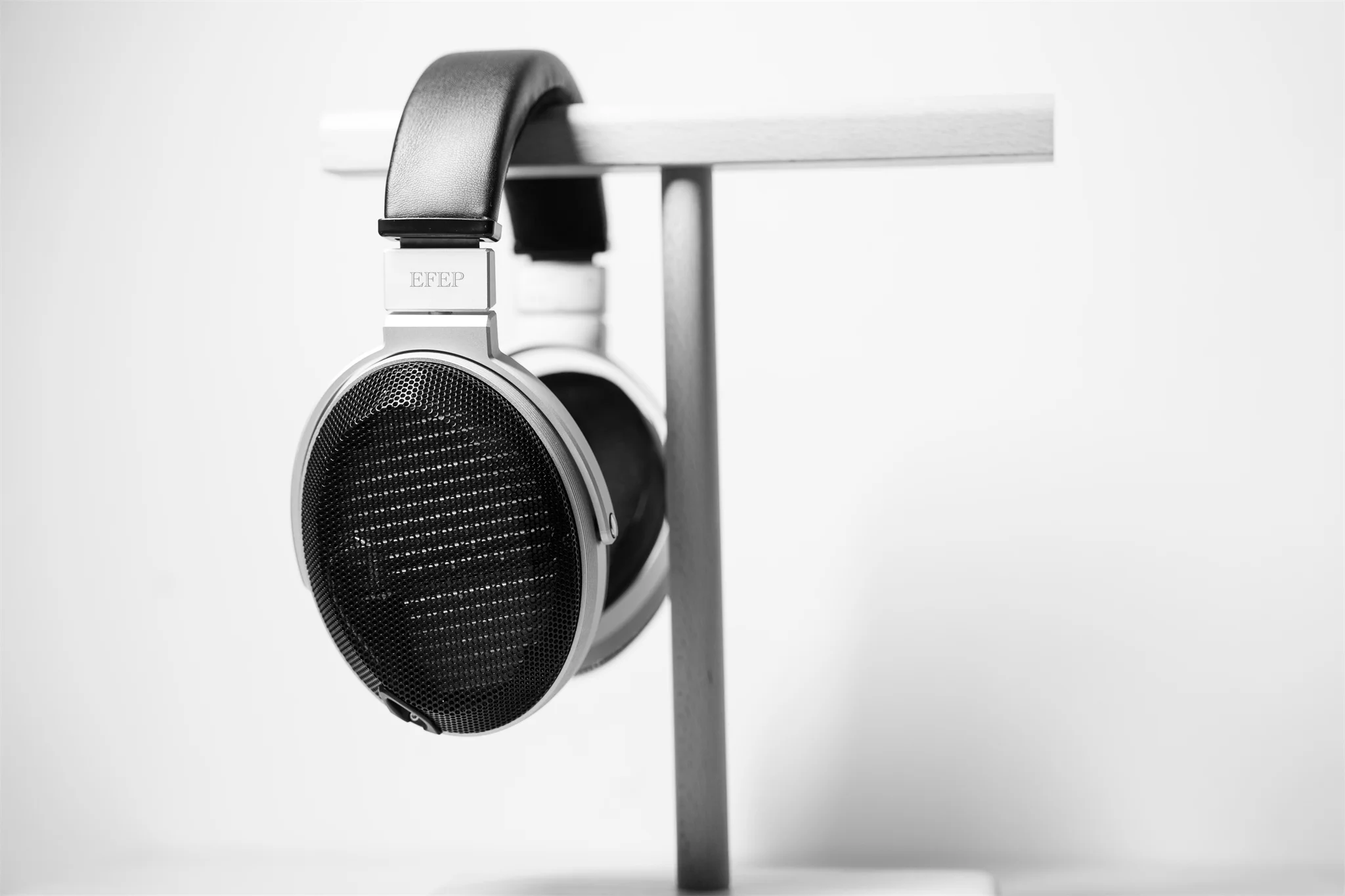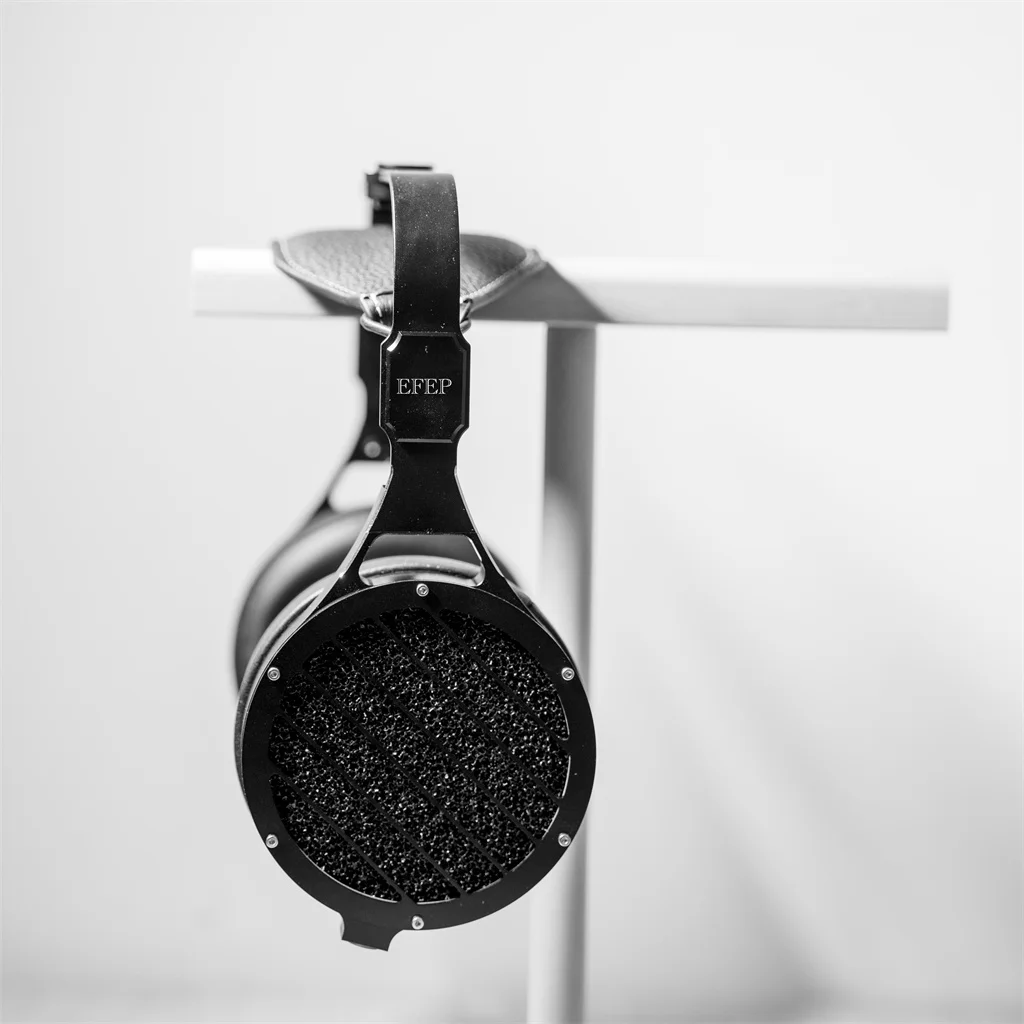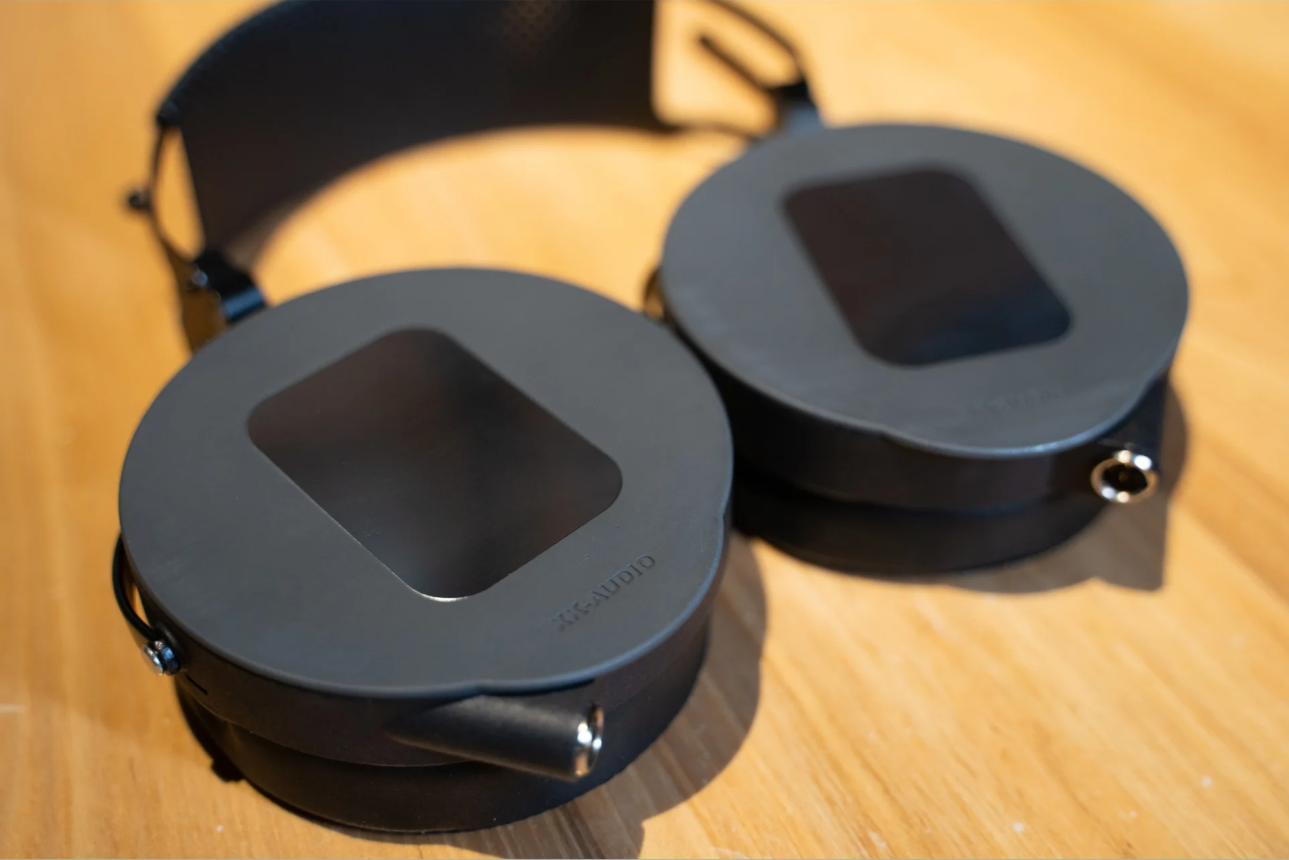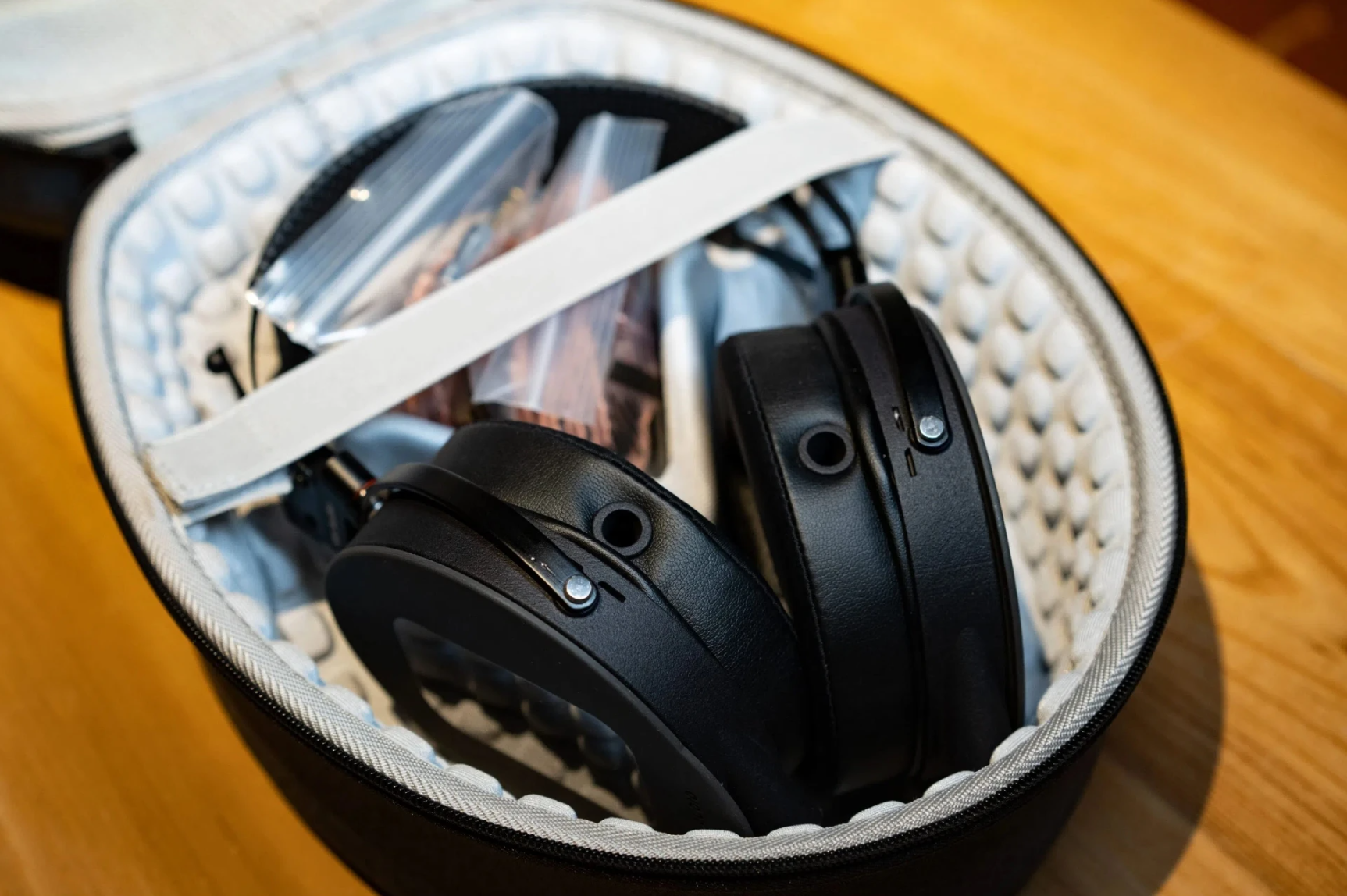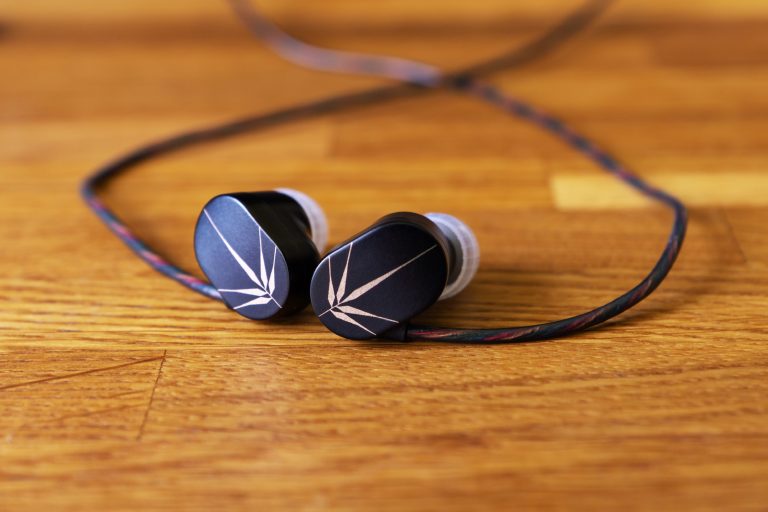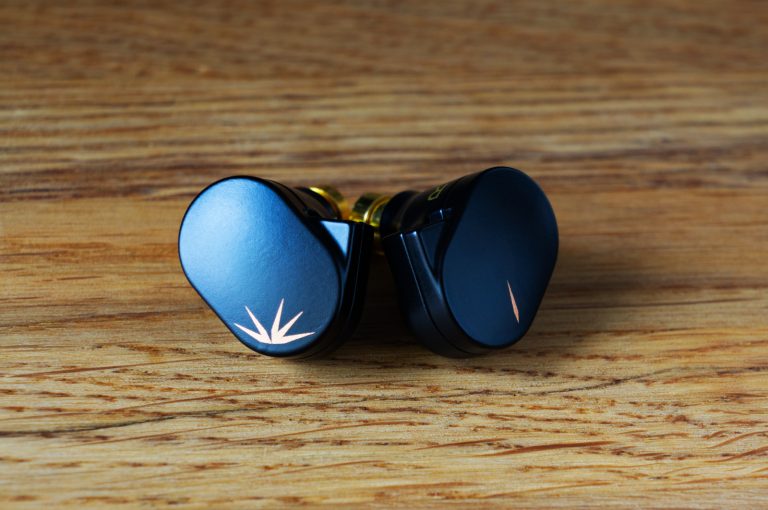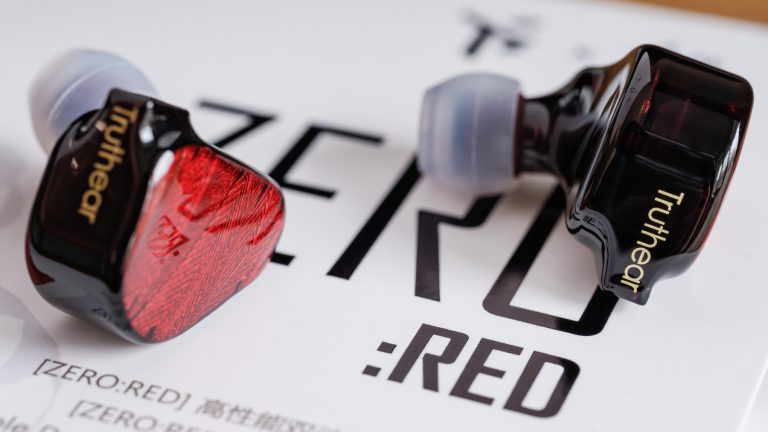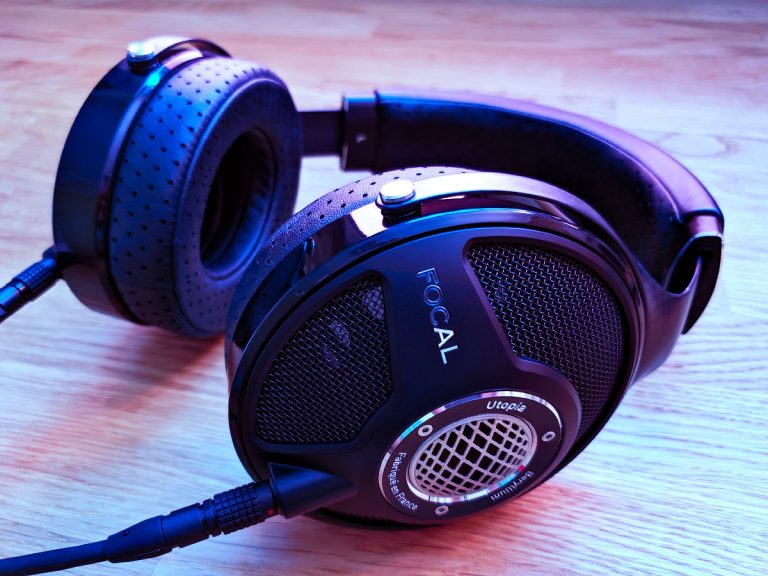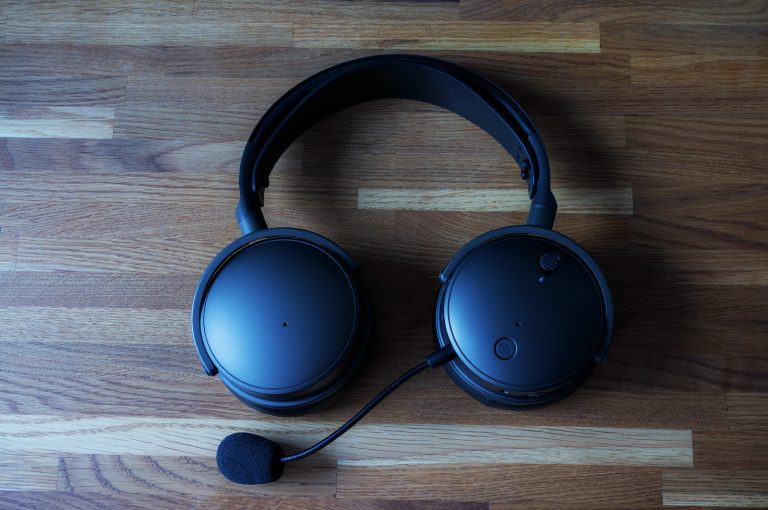XK Audio Fluxion Over-Ear Headphones Review
Sometimes I just want a little audiophile miracle so that, while browsing websites, I come across some unknown headphones, and there’s not a single review about them in any language, and there are next to none measurements of them… and so that their price is not too expensive… and I buy them, and they turn out to have just a magical sound, and are comfortable, and the earpads can change the sound…
That’s how I came across a post about products by XK Audio while browsing Reddit. This is a Chinese DIY company that started by copying models of well-known manufacturers and then swung to their own creativity. Here I’ll note that their early models looked like this, for example:
The headphones have the EFEP brand name on them. For some reason, XK Audio is present on Aliexpress under that name. That is, no one claims that we are looking at T+A Solitaire P and Abyss 1266, but… it’s not difficult to see a certain similarity.
After a while, XK Audio started releasing their original models: Avalon, Ken, Avalon mk2, Fluxion and then Serene, which is their flagship model for today. I may be mistaken in the order of appearance of these headphones because there is incredibly little information about XK Audio in the English-speaking online segment. Their official account belongs to the bilibili platform, and sales are maily conducted through Taobao. On Reddit, you can glean some rumors and speculation in several posts, the authenticity of which remains a big question.
In short, since I desperately wanted a miracle, I decided to buy a Fluxion model. I looked at the few measurements, then at the Fluxion price, then at the prices of other headphones with the same measurements and, with the last doubts removed, paid for the order.
Was it completely reckless? Perhaps, but only partially: three months earlier, I had already purchased Avalon mk2 and, therefore, had some reason for my expectations. And the expectations after getting to know Avalon were, frankly speaking, high. So, today we’ll talk about XK Audio Fluxion, very rare planar, fully open-back headphones. HiFiMan calls this design of the earcups ‘unveiled’. The price paid is $980 ($900 for headphones plus $80 as the customs duty).
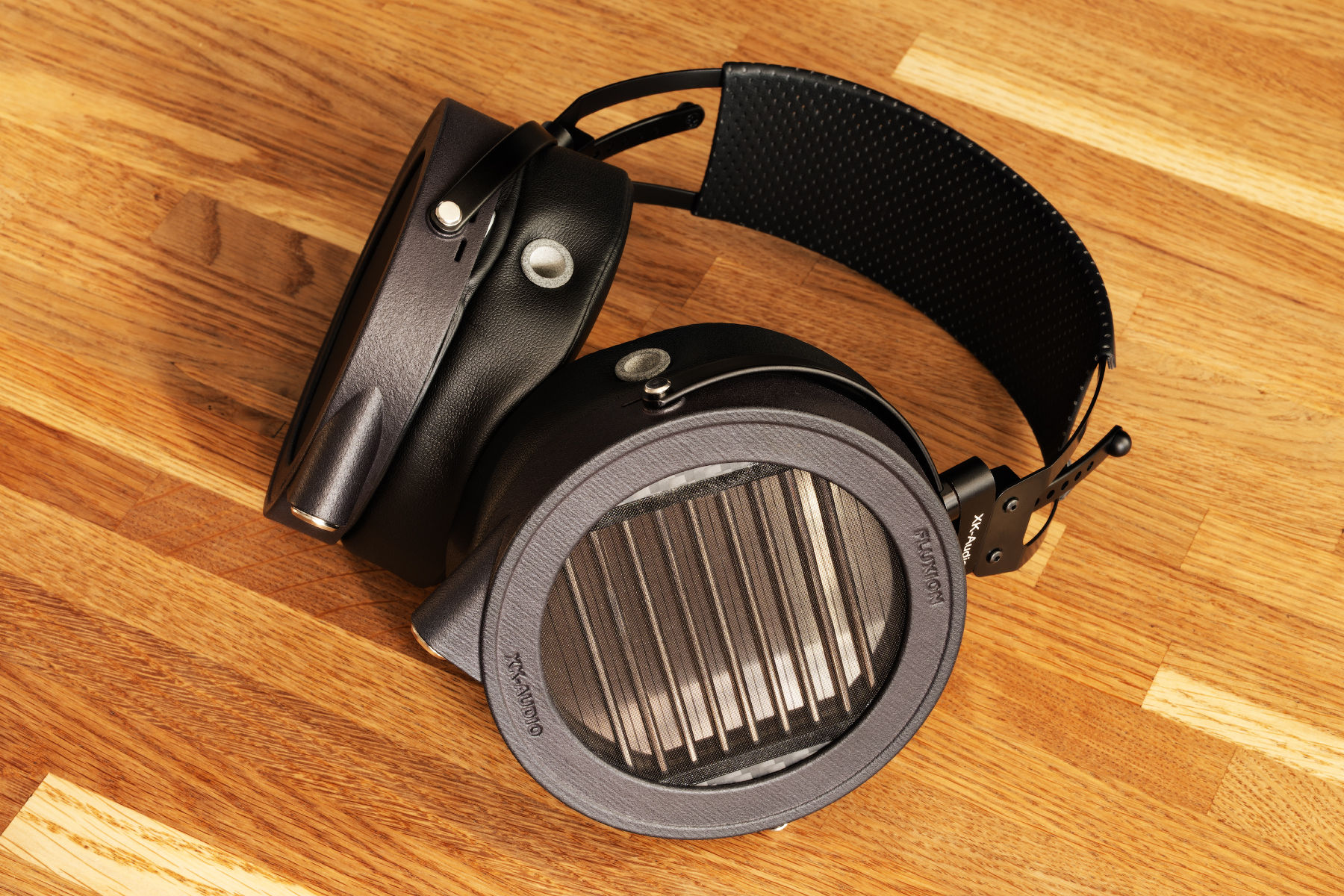
I couldn’t find any text reviews of them on the Web or any videos about them on YouTube. There are just some video reviews on bilibili. In the Chinese language, of course. No information on their weight, distortion, etc.
That is, it seems (IT SEEMS!) that this will be the first full-fledged review of these headphones on the Internet.
What’s included
For once, it will be a really meaningful section.
There was a hefty case in a tight bubble wrap bag inside the shipping cardboard box. What I found it in the case:
- the headphones;
- a cable (as requested, with a 6.3mm connector);
- a soft headband overlay;
- a warranty card;
- 3 sets of eartips.
It’s hard to convey my astonishment because, judging by the product pictures on AliExpress and all the known Fluxion images, the kit should have included earcup covers because the driver is covered only by a thin, completely transparent mesh, and the headphones may actually suffer during transportation – there’s about a centimeter from the driver membrane to this mesh.
But there were no covers in my kit. The headphones were simply put in a case, and the earcups were propped up with foam pads on the outside. Everything arrived at its best, but I still got scared and relaxed within one second right after opening the case.
Secondly, the earpads in one of the sets were literally of different sizes. They differed by about a centimeter in diameter.
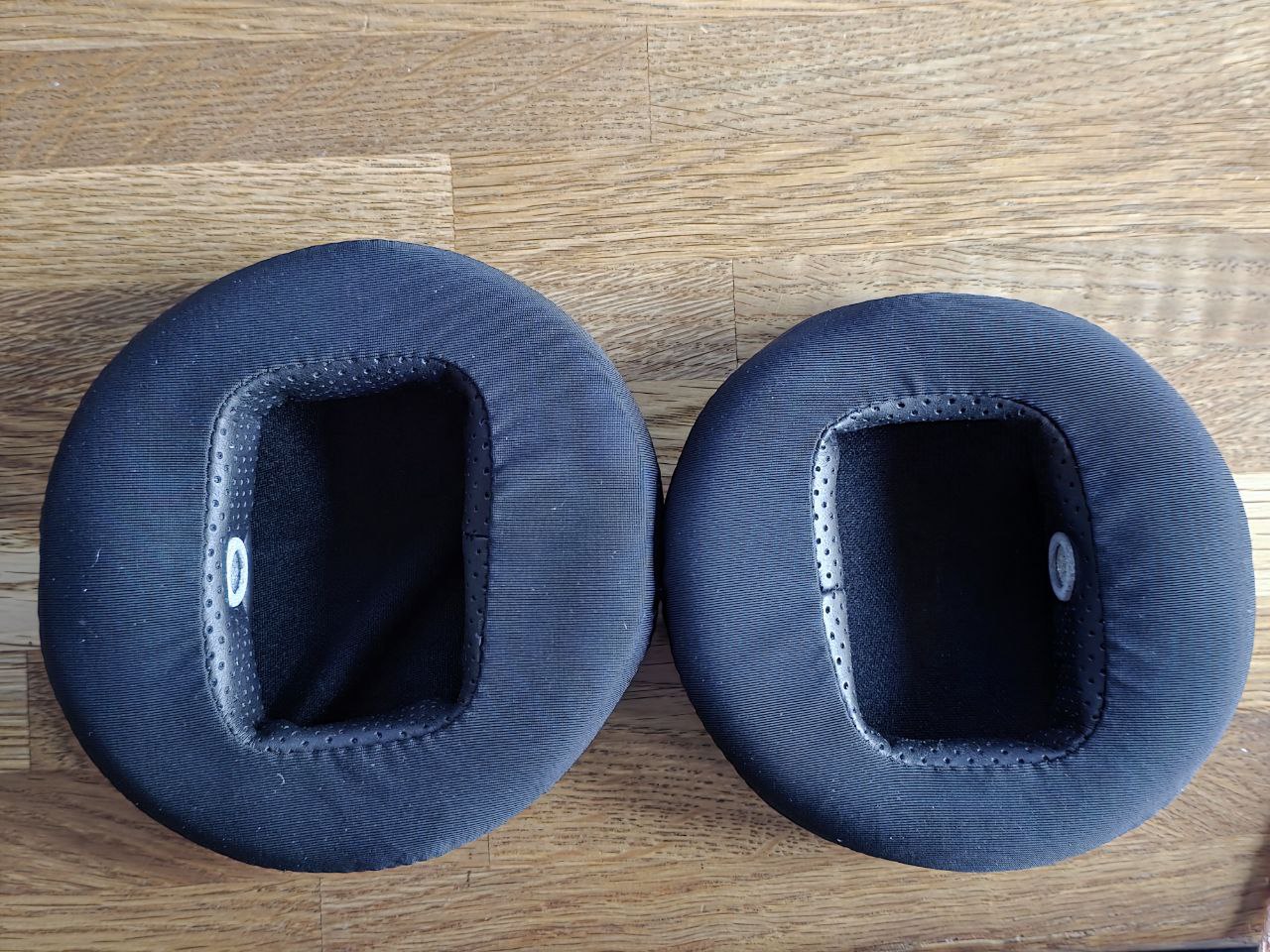
I immediately informed the seller and received the following answer: as for the earpads, this is their fault, so they’re already sending a normal set. But covers are no longer supplied because someone managed to damage the headphones (drivers, apparently) with these covers.
I won’t make any assumptions about whether the seller is lying or the situation with the covers is really like this. I’ll just mention the very fact that the headphones can arrive without them.
The warranty card makes it clear that we’re looking at Fluxion specimen #90.
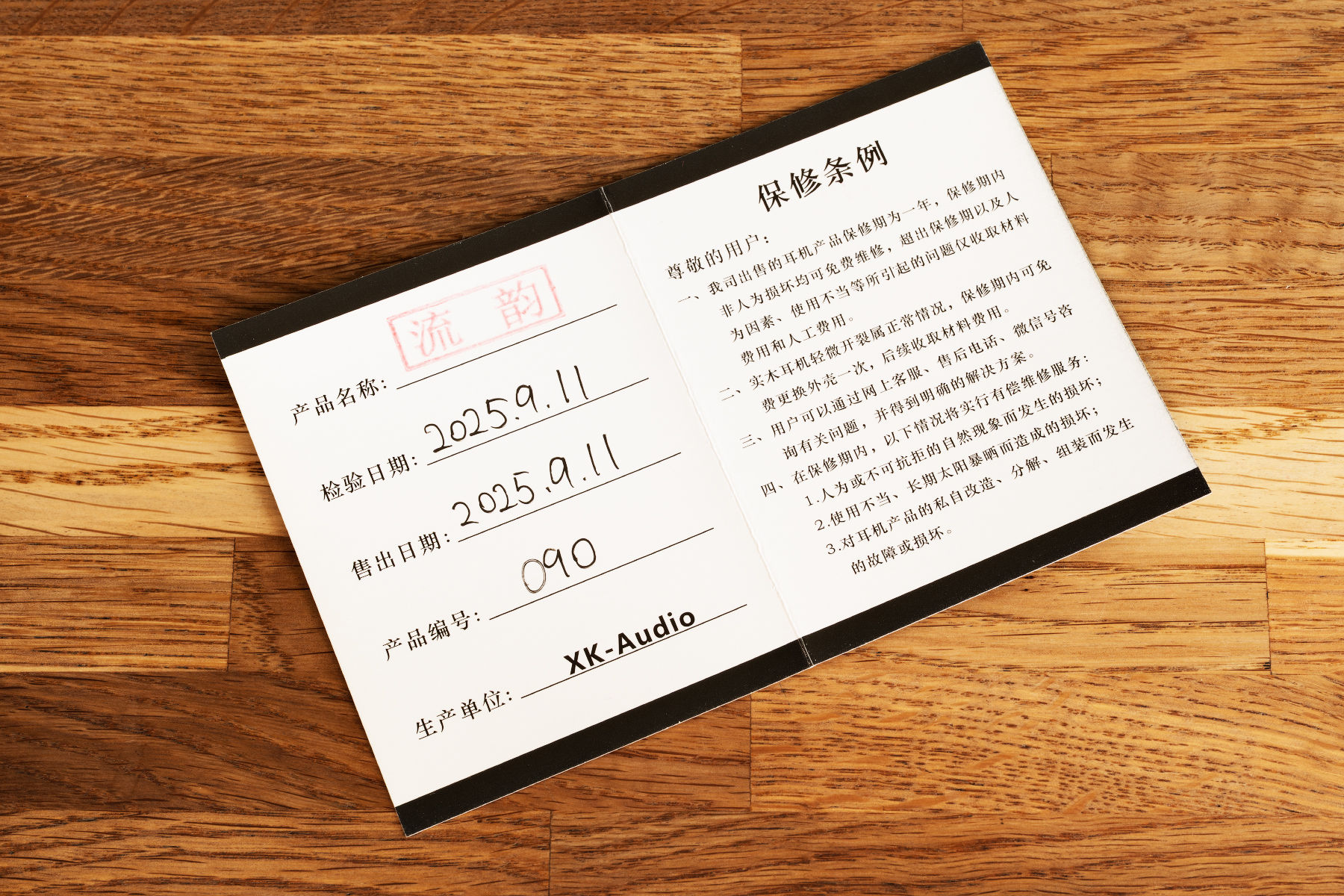
The post about the 10th specimen was made on Reddit 6 months ago, from which we can conclude that 10-15 items of the model are sold per month.
However, let’s return to the kit.
The earpads are of three types, all flat, without bevels:
- Meshy ones, almost weightless, 2.4 cm thick. Inner width/height are 4.6×6.8 cm. They are listed on my squig.link as ‘stock mesh pads’.
- Leather ones with compensation holes (hollow tubes are inserted right into the earpads), 2.9 cm thick. Inner width/height are 4.3×6.2 cm. They are listed on my squig.link as ‘stock vented pads v1’.
- Fabric ones with compensation holes and cooling gel inside, 2.7 cm thick. Inner width/height are 4×6 cm. They are listed on my squig.link as ‘stock vented pads v2’.
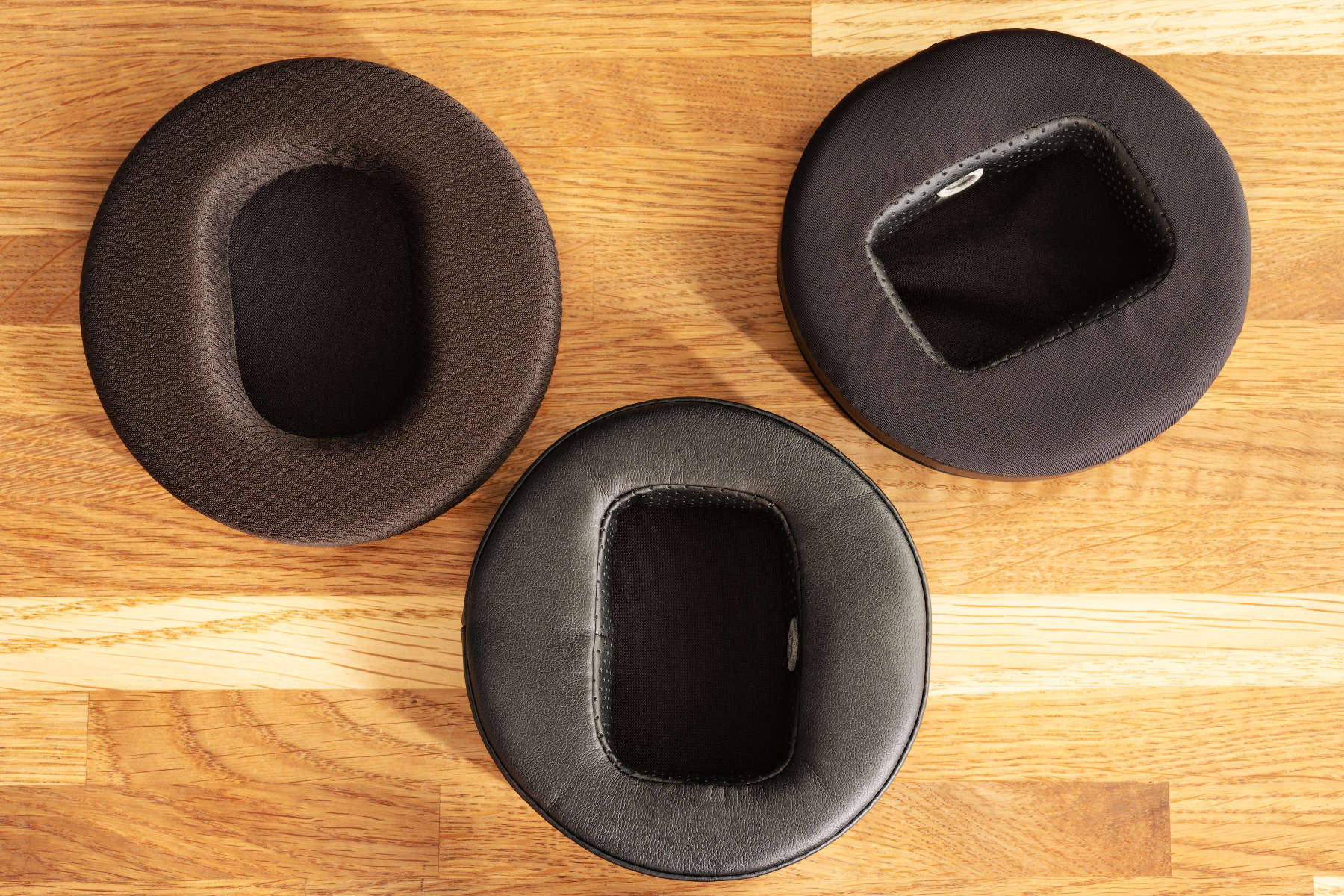
The cable is a regular one, about 165 cm long and with resistance of 0.4 Ohms.
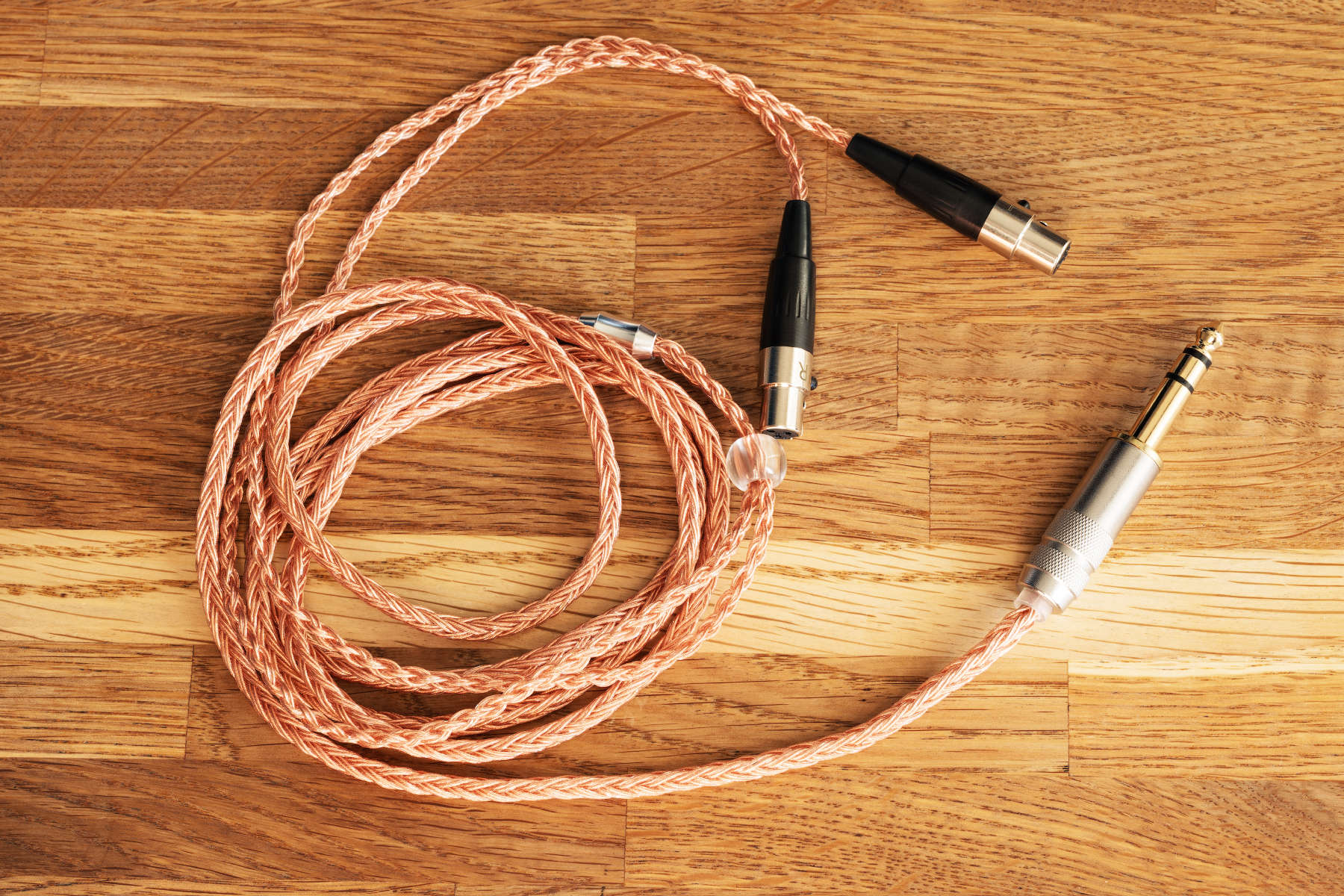
Physical characteristics
Fluxion are fully open-back headphones based on planar drivers with a two-way magnetic system. The manufacturer states that the size of the driver is 110 mm, and it seems to be its total height or width, not so clear. The area of the visible part inside the headphone is 82×66 mm.
The radius of the round plates, on which the earpads are placed, is 10.5 cm, while the diameter of the earcup is 11 cm.
Let’s come to the weight:
- the weight of the headphones themselves (earcups + headband, without earpads) is 406 grams;
- the weight of the earpads:
- meshy – 28 grams per set;
- leather with holes – 44 grams per set;
- fabric with holes – 95 grams per set;
- the headband overlay – 16 grams.
Thus, depending on the earpads selected, the headphones can weigh from 450 to 520 grams, give or take, without the cable.
Workmanship
The earcups of the headphones are 3D printed, and the plastic is additionally handled. For 3D printing, the surface looks nice.
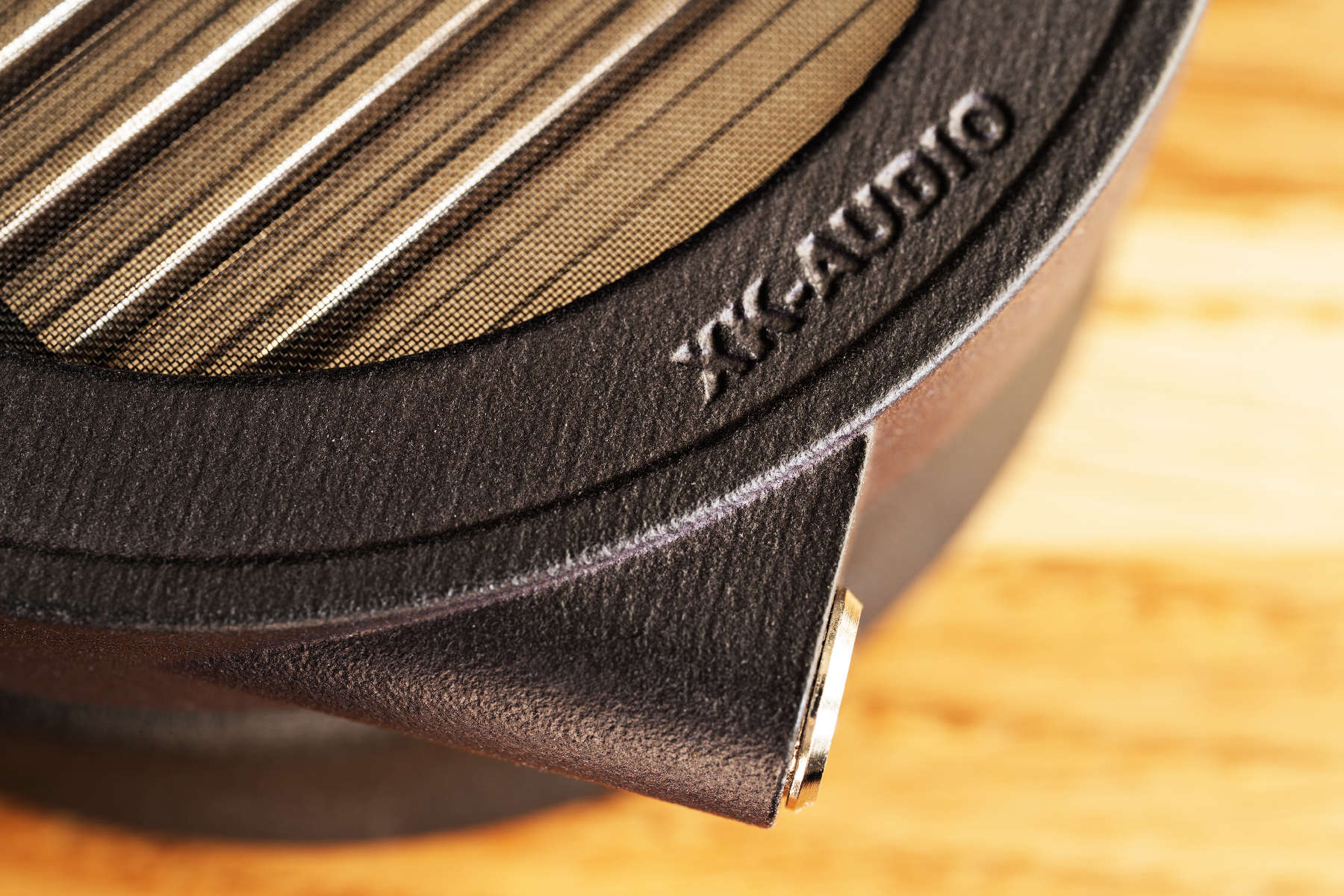
My feelings about the assembly are mixed because it looks like the headphones were assembled by two different persons. The first one did their best: the meshes are stretched and glued flawlessly, and the drivers are aligned perfectly relative to each other.
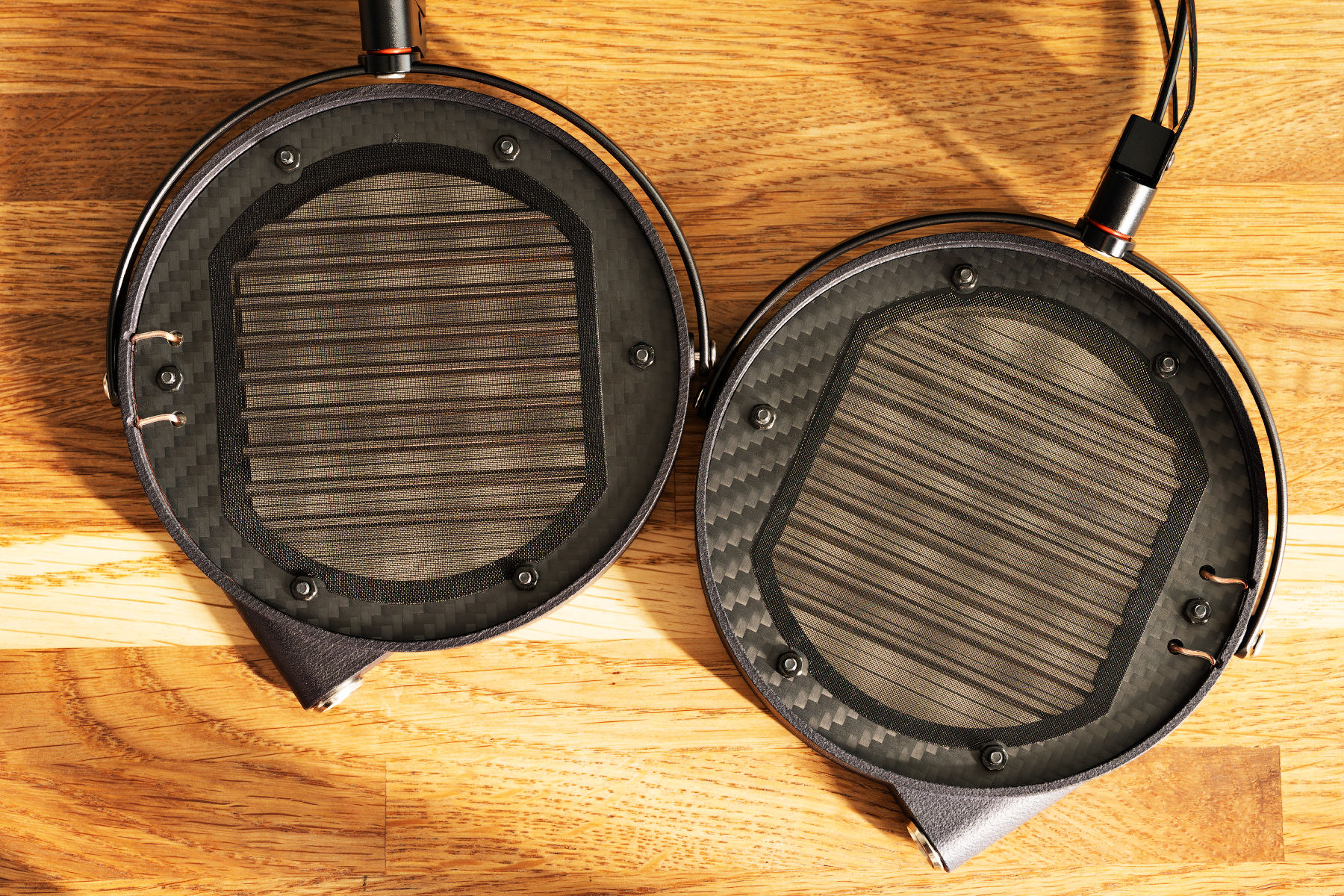
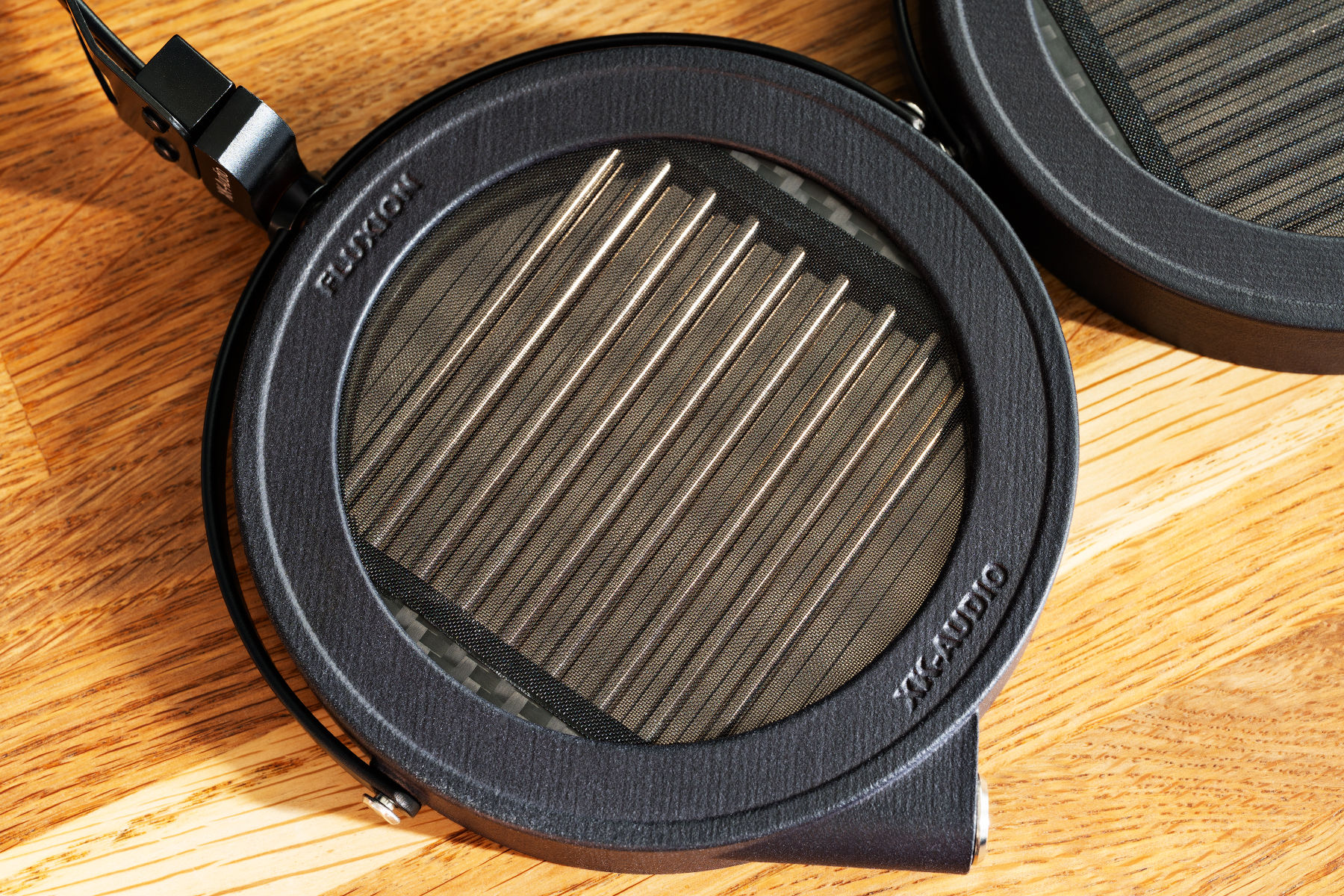
But the second one didn’t really bother: the connectors on the headphone side are placed at different angles.
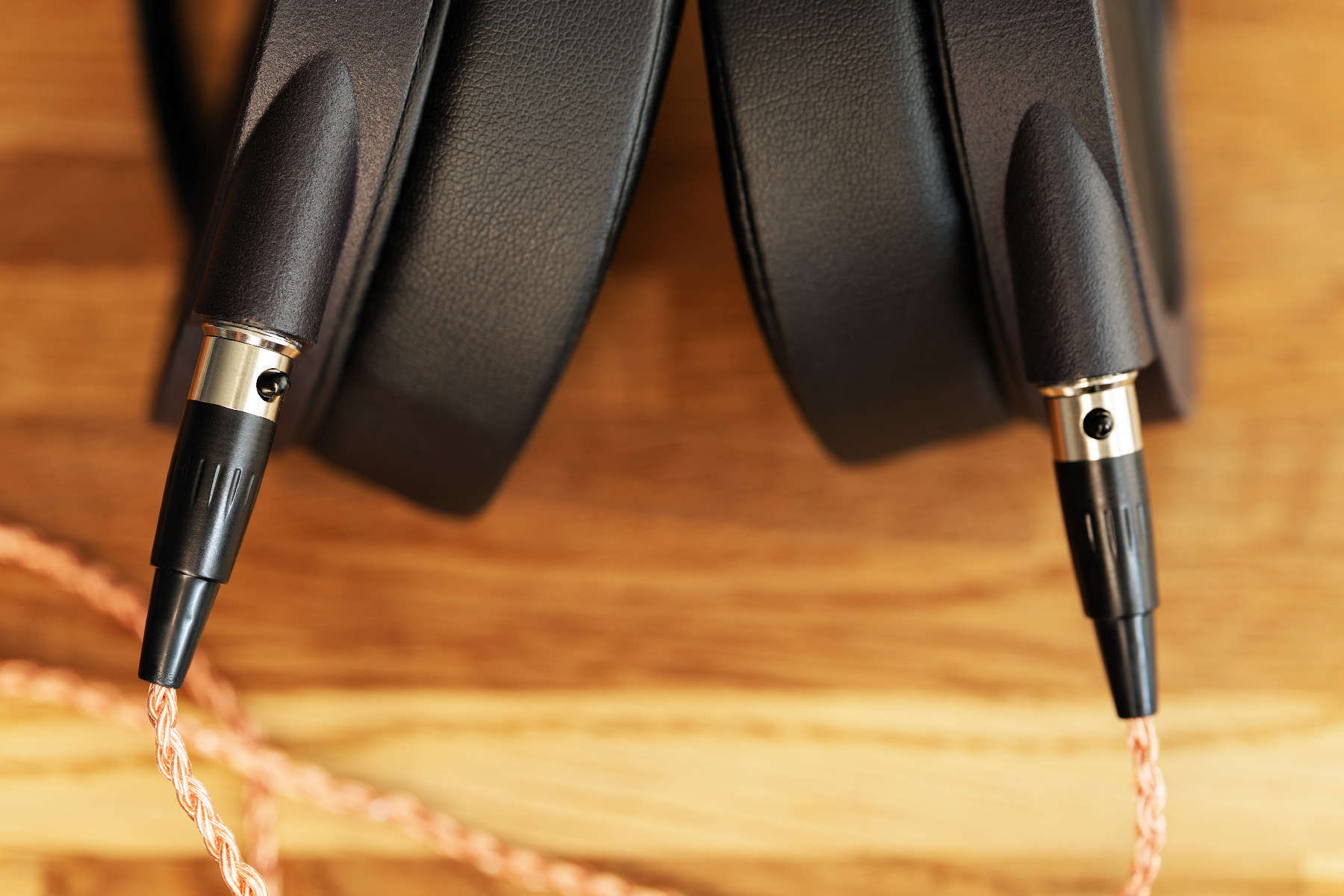
The connector pins look different (have they been made by different manufacturers?). The relabeled pins of the connector on the right look especially funny.
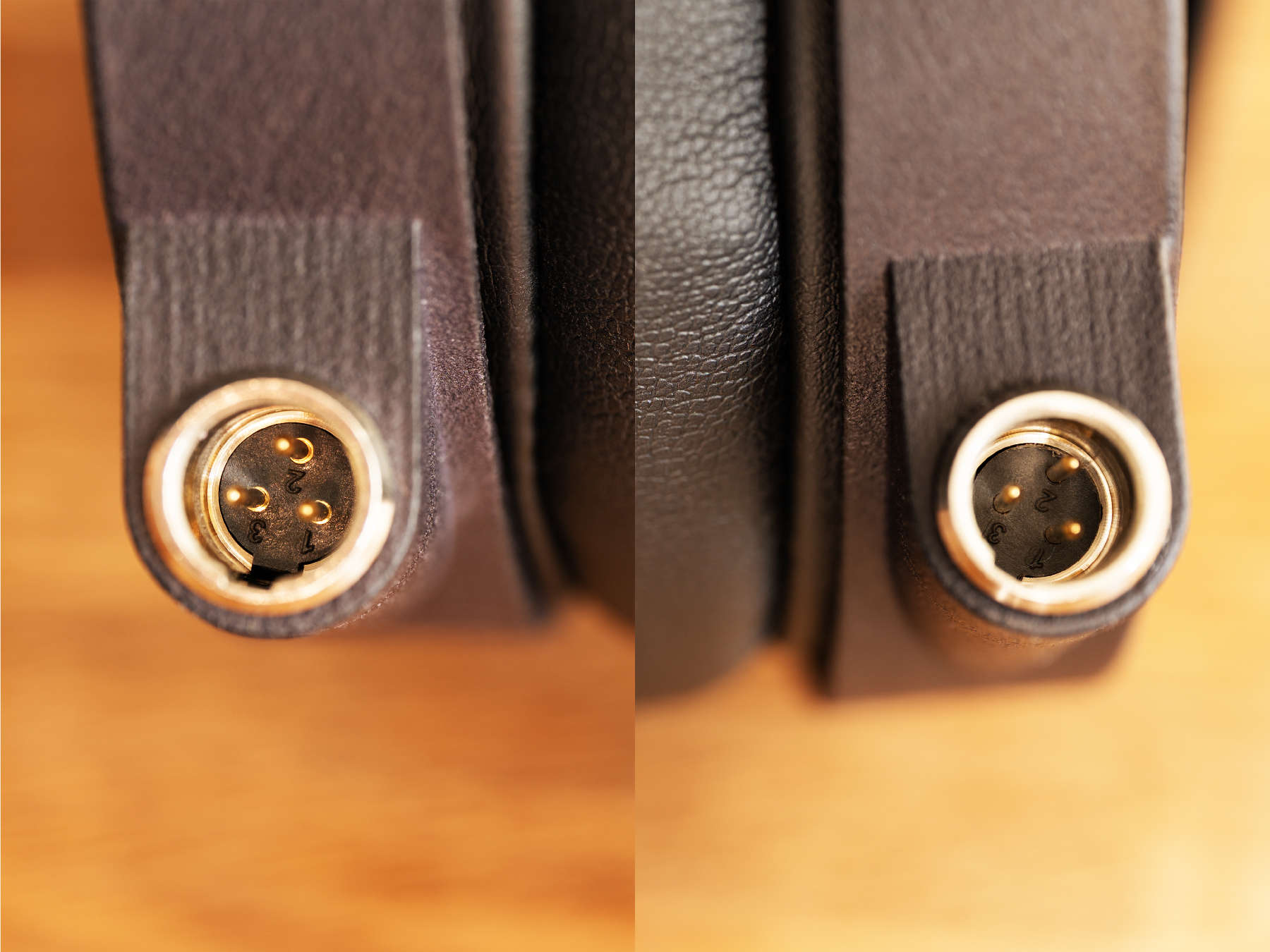
The headband is a simple and cheap Chinese one for $35, freely sold on AliExpress. The earcups have limits of rotation around the vertical axis, but they hang freely within the limits allowed. The screws of the arcs that attach the headband to the earcups are tightened with different forces on the right and left headphones: the position of the left earphone can be fixed frictionally more or less, while the right one rotates freely around the horizontal axis.
What’s more, the headband is bent a bit crookedly.
The mechanism for attaching the earpads is very… ‘original’.
A 3D-printed ring is inserted inside the earcup. It’s inserted with exactly the right side because it has recesses for the wires inside the earcup.
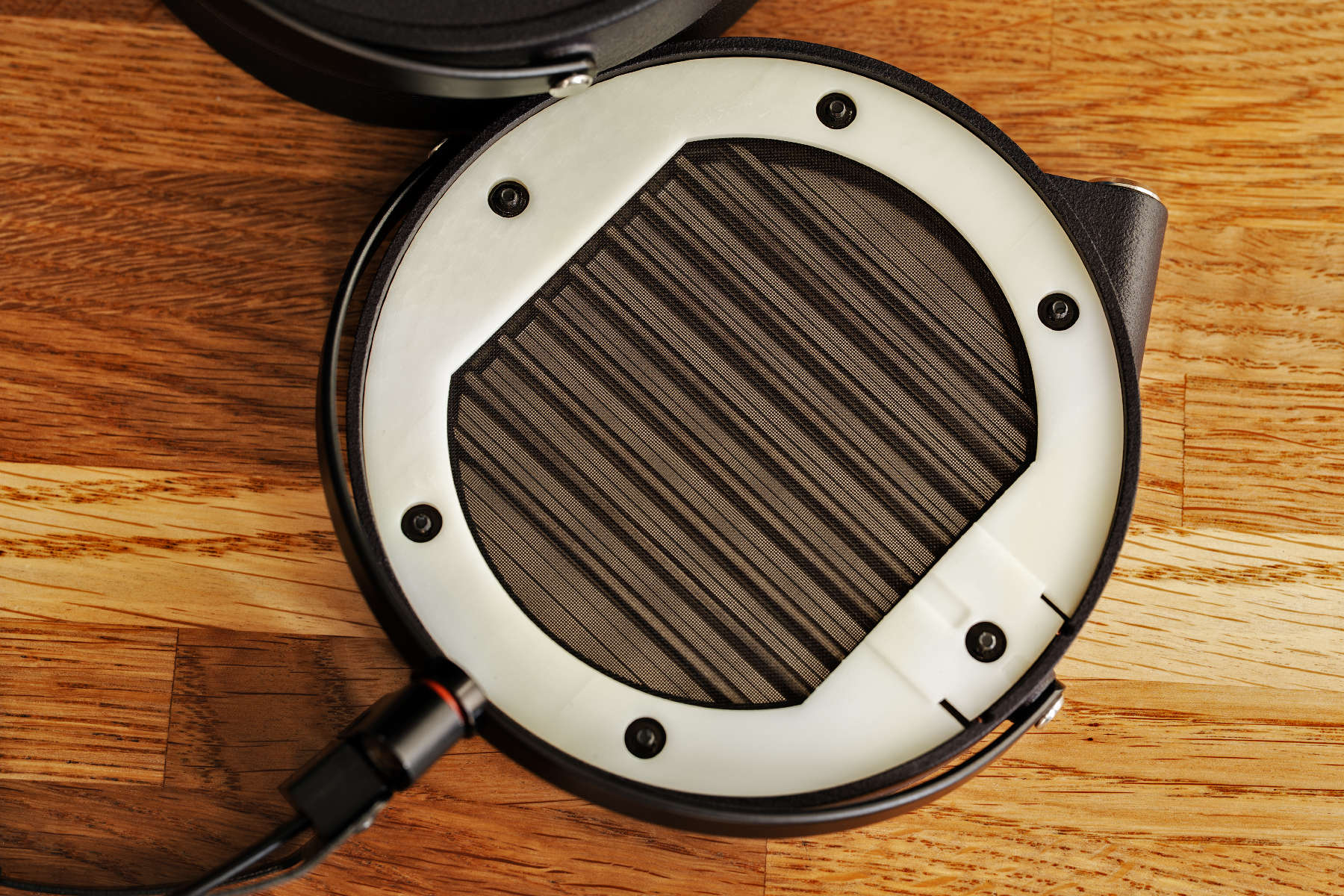
The ring rests against the edges of the earcup edge and is held just frictionally.
The earpad is put on the ring for a reason: part of its ‘skirt’ must pass through special slots and along the outside of the ring.
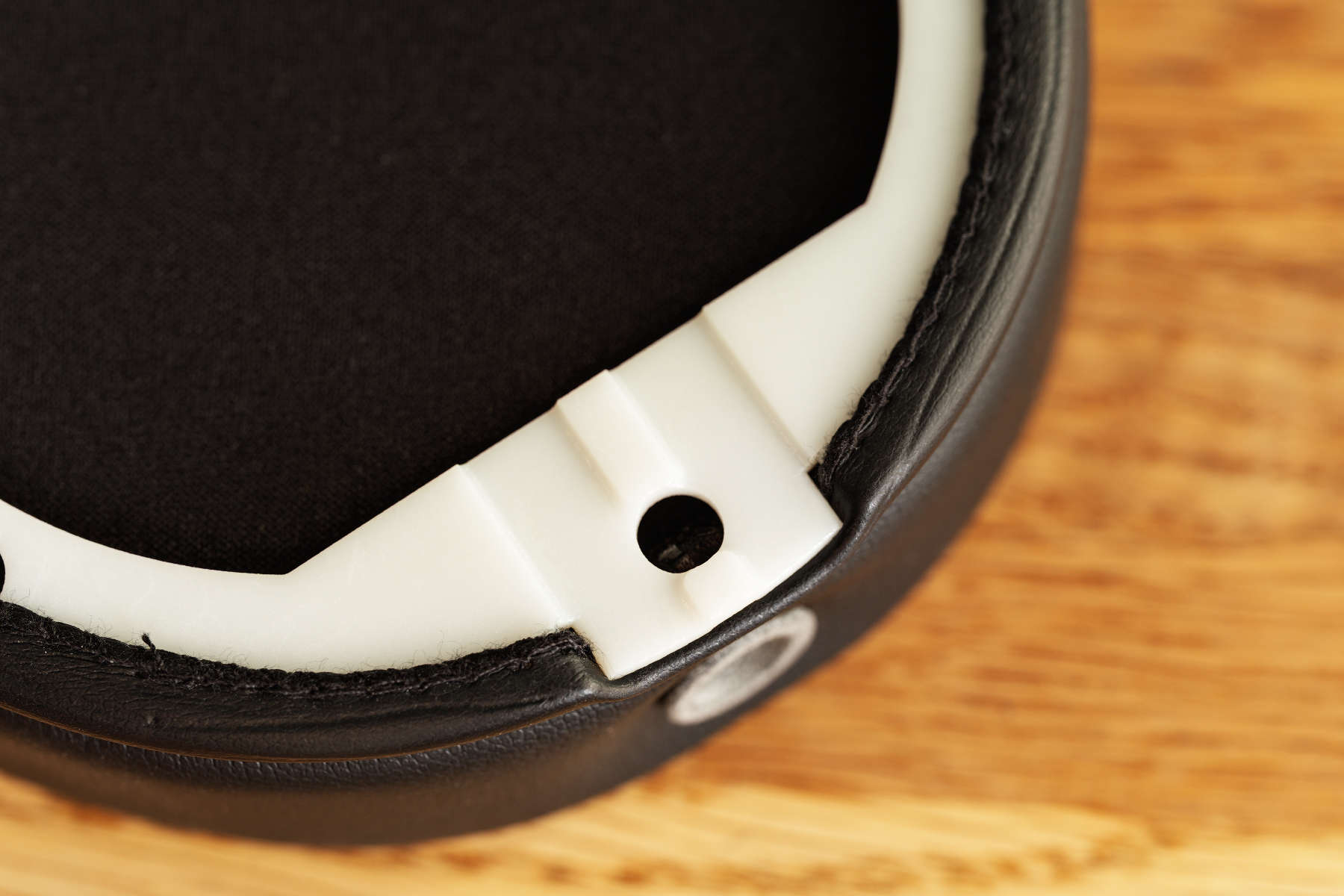
At the same time, the ‘port’, or a hollow tube in the earpad, should be behind the ear, according to the manufacturer.
Then you need to put the ring with the earpad to the earcup and gently push it through, putting it on the protruding screws with nuts. That said, the edge of the earpad will be clamped into the gap between the ring and the earcup and additionally fixed in the holes for the screws.
Therefore, in order to take off the earpad, you need to put your finger inside and, taking hold of both the plate and the earpad, pull them away from the earcup. The earpad pops out of the earcup abruptly, so every time it seems to me that something will definitely break (but I’ll be honest, the whole thing is intact after almost 15 replacements on each earcup).
Overall, Fluxion is nowhere near premium. This is a well-printed, but carelessly assembled and not very well-designed product.
Usage experience
When the headphones are not on your head, the earcups dangle in all directions, and there are no protective plates on their outer sides. Therefore, every time you have to put yourself to some bother and focus on figuring out how to safely hold the headphones with your fingers or how to put them on the table. It’s annoying at first, but then you get used to it.
The way of the attachment of earpads to the earcups has the following consequences:
- there are no air gaps between the earpads and the earcups, and this is good;
- since everything is hold frictionally, you cannot turn the earpad after it’s ‘inserted’ into the earcup;
- the skirts of the earpads deteriorate as they get stuck in the holes where the screws enter.
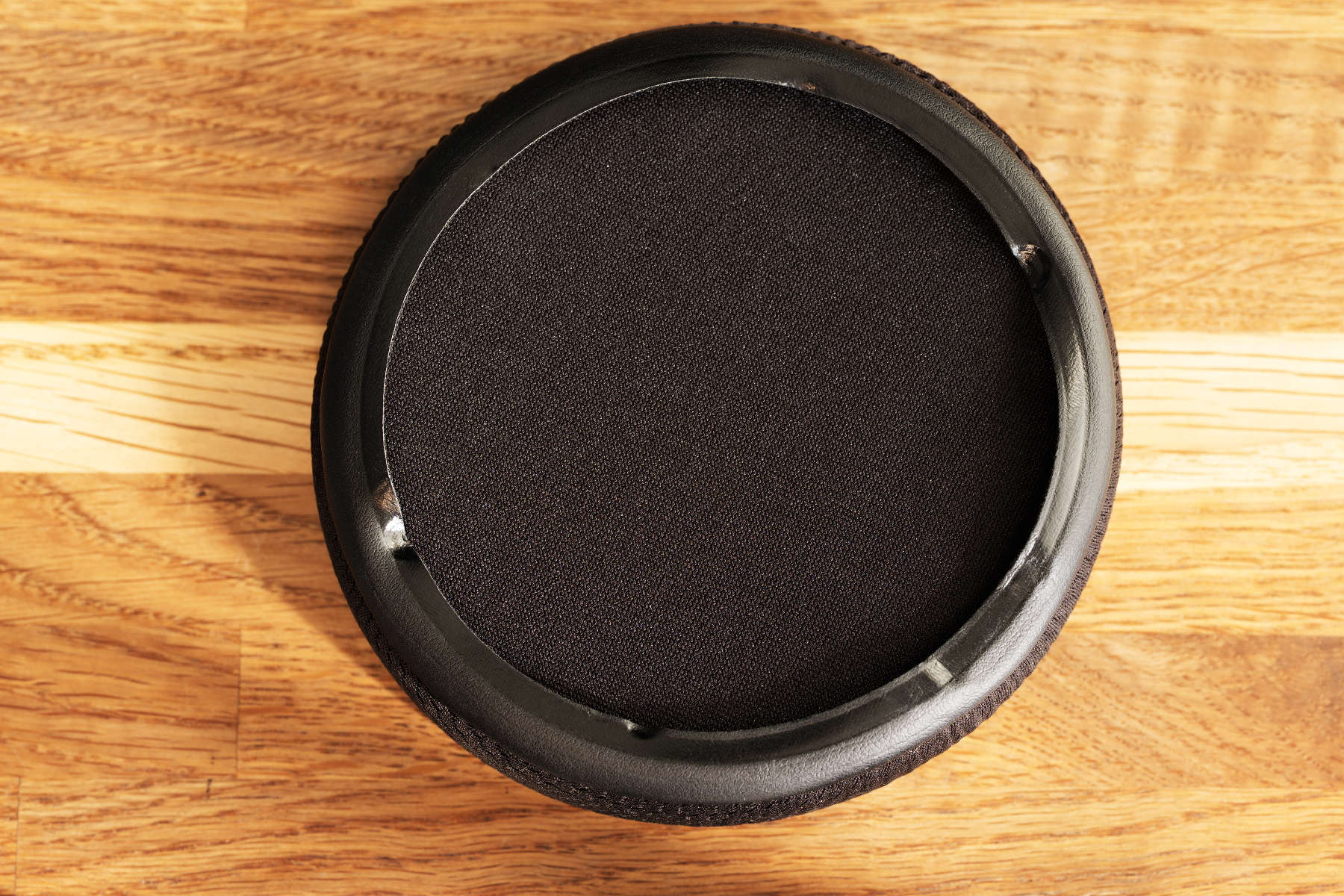
That is, the mechanism is not only frankly inconvenient, but also slowly deforms the skirts of the earpads, especially if they are changed often. The manufacturer wanted to solve the problem with an unstable air gap, and they managed, but they also could just make a magnetic attachment system, like Moondrop PARA has.
As for the rather big weight, well… it’s not a problem, all of a sudden. All standard earpads have a area of contact with the head that’s large enough so that part of the weight of the headphones is ‘held’ by the very friction of the earpads on the scalp and not on the headband. Besides, the fabric overlay on the headband slightly improves the situation.
I’ll also note that the ears start sweating in leather earpads, almost like when wearing closed-back headphones. So it becomes clear pretty quickly why the earpads with cooling gel were included in the kit. But the possibility of ordering such earpads, if the situation requires it, remains questionable. I could not find anything like this on AliExpress.
The headband is huge. With my big head, I can use the headphones without pushing out the earcup arms at all, or to one position at most. If you have a small head, I suspect that the headphones will be hanging on your ears, or you will have to come up with sort of a thick headpad.
In general, when the headphones are on my head, I rate their ergonomics as high, but it’s frankly not convenient to handle the headphones ‘outside the head’, let alone the comfort of changing the earpads. If there were some protective covers and a headband that holds earcups stably, it would be a different story, and it seems to me that it’s absolutely legitimate to demand this for $3,480.
Sensitivity and impedance
The manufacturer provides the following figures: 96 dB/mW sensitivity at 25 Ohms of impedance.
I won’t comment on the sensitivity value in any way, but I can measure the headphones’ impedance on my own now thanks to one good person:
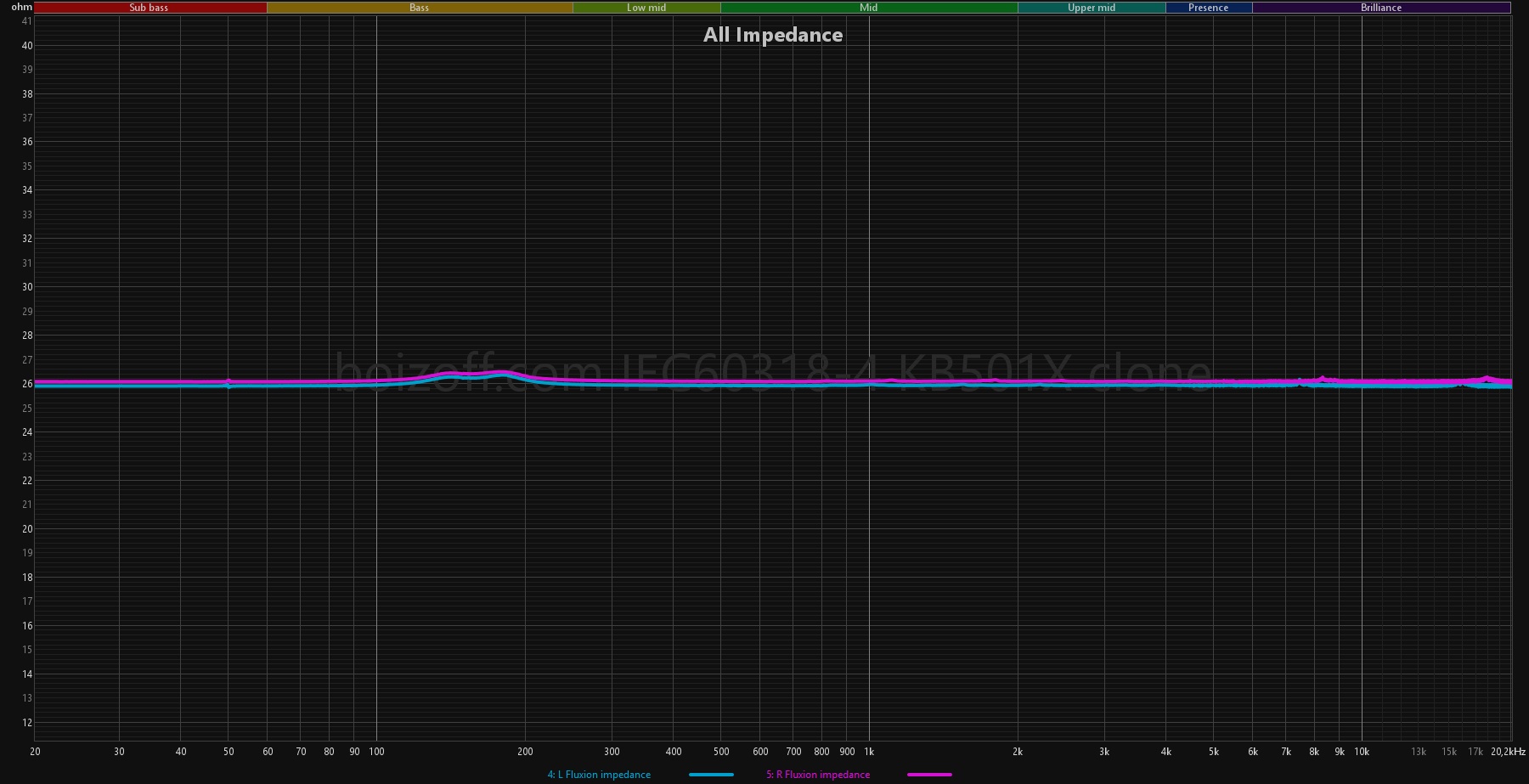
That is, there is an almost linear graph at the level of 26 Ohms.
Sound
Standard links:
- the description of my rig is here;
- the audiogram of my hearing is here;
- the nuances of headphone measurements are here;
- articles on the measurement theory and the whole shebang are here.
Since the earpads are very different physically, the Fluxion sound with different earpads will be very different, too.
Fluxion’s frequency response when using leather earpads with holes, with the port open, with an ideal fit on the rig without air gaps between the earpad and the rig plate:
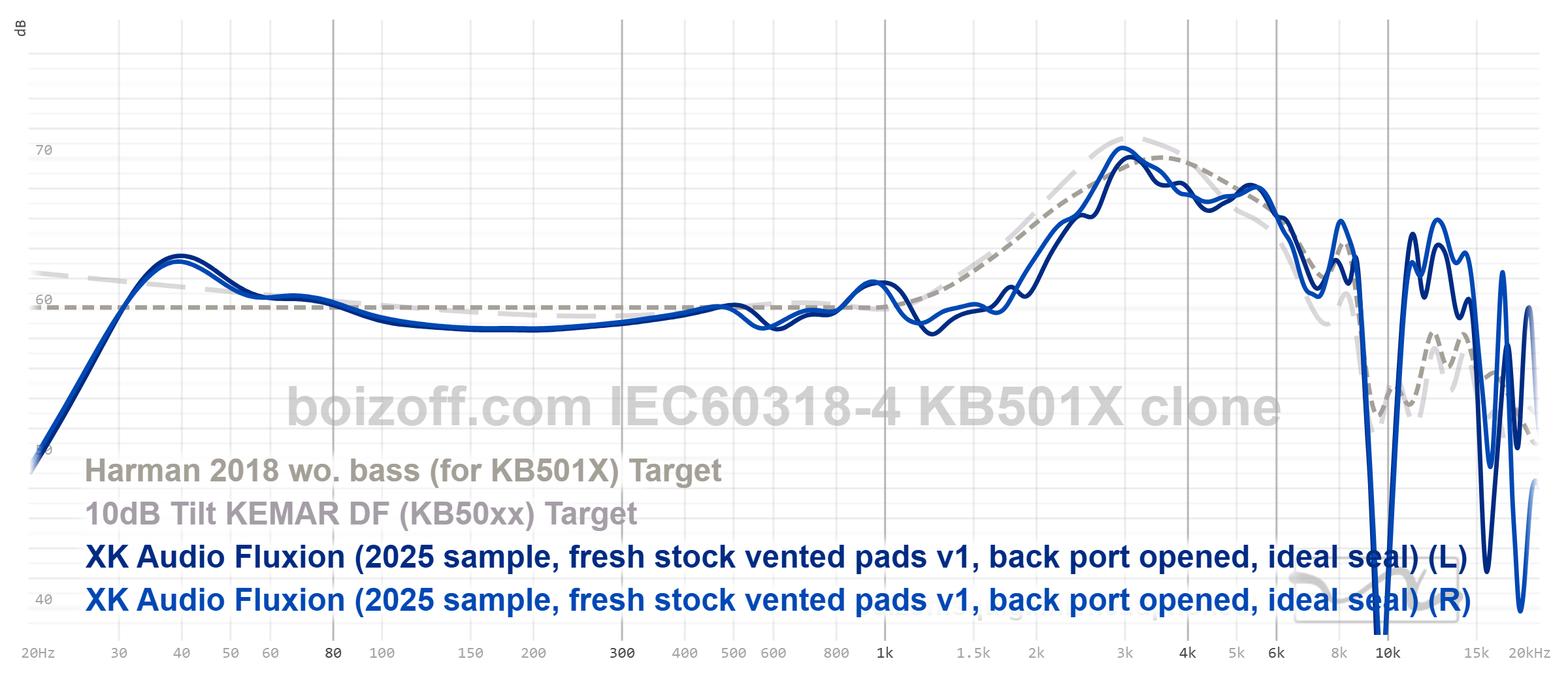
We can see a fairly ordinary frequency response for open-back planar headphones – this is an almost linear graph from 60 to 1000 Hz, a curve more or less corresponding to the diffuse field in the 3-10 kHz range, and a significant emphasis around 13 kHz. What distinguishes Fluxion from many others is the lack of a dip at 1.5 kHz and the lack of emphasis at the 5-7 kHz range, as well as emphasized 40 Hz, of course, which is due to the holes in the earpads.
Frequency response graph for the same earpads, but with a small air gap:
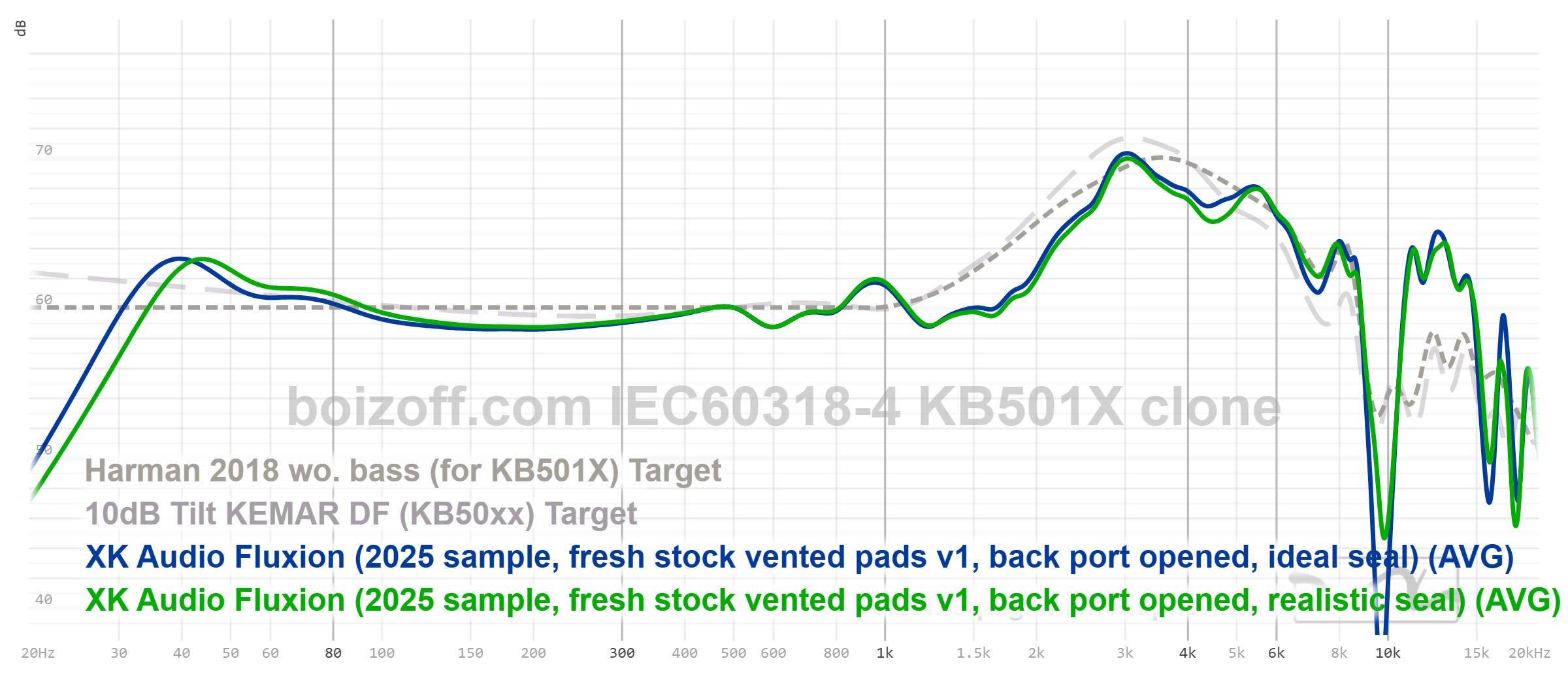
Everything is the same, only the emphasis on the subbass has shifted to the right.
Measurements with the same earpads, but with blocked holes:
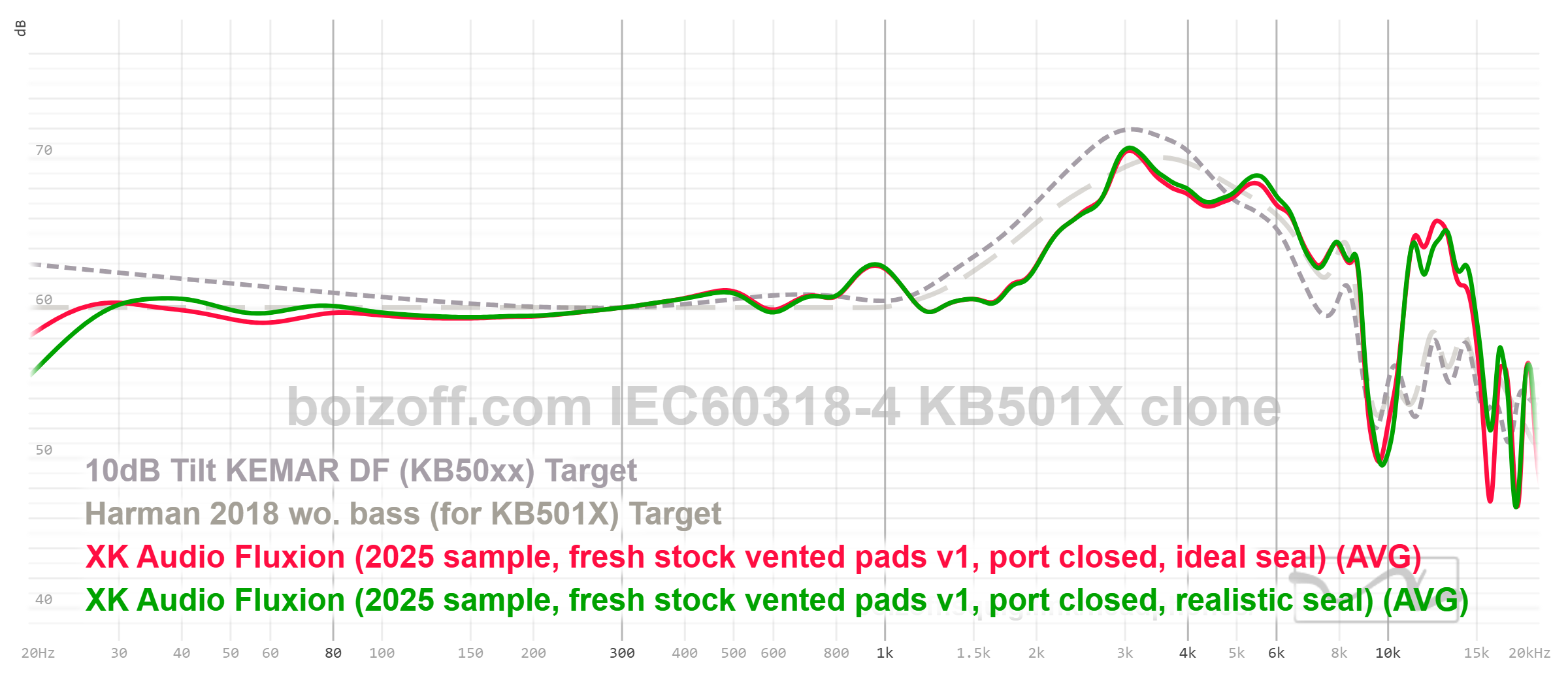
The graph on the segment of 20-100 Hz has become almost linear, and the interval of 2-5 kHz has slightly ‘sunk’.
Comparison of frequency responses with closed and open holes:
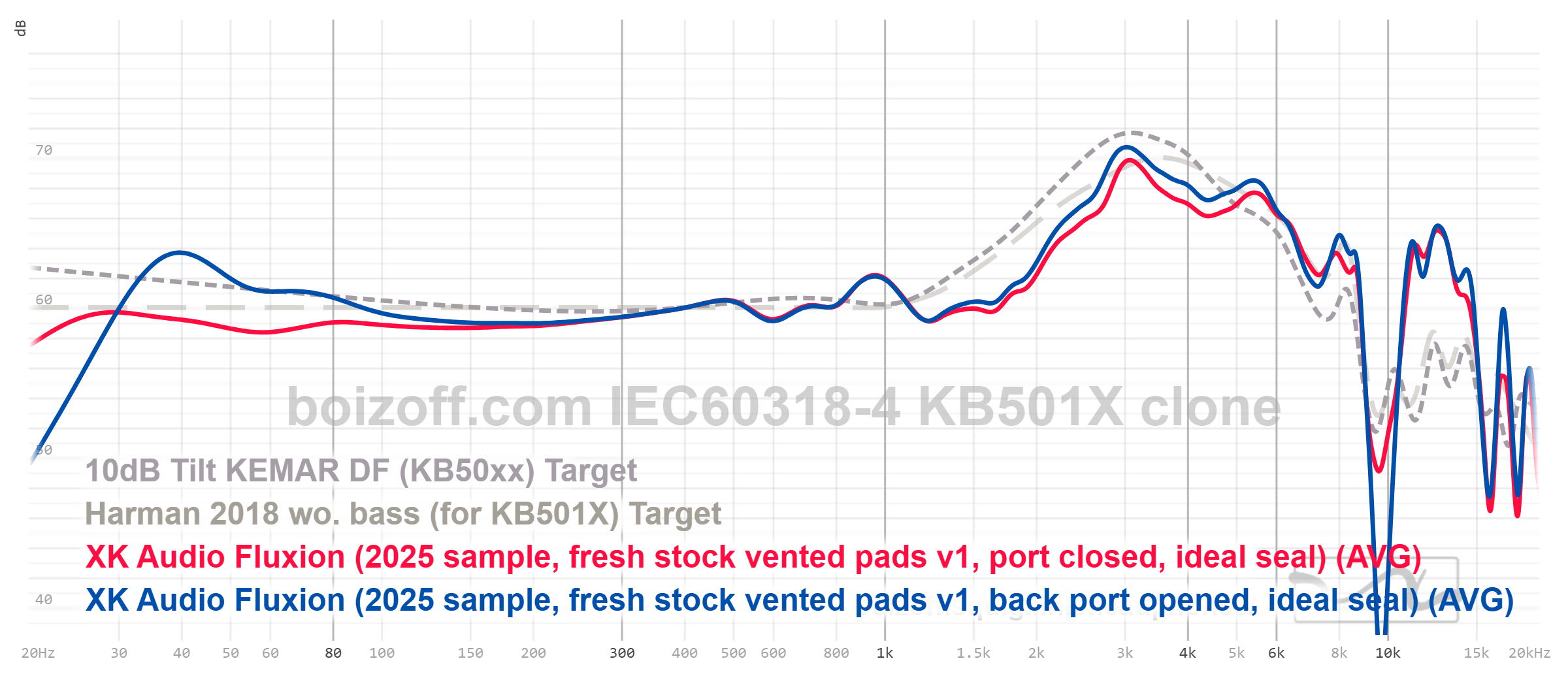
- With leather earpads, if you leave the ports open, Fluxion can be regarded as open-back planars that are fairly ‘classic’ in sound, but having a noticeable subbass, which open-back planars usually lack. They also don’t have annoying high frequencies, for which many people actually don’t like relatively cheap planars. In other words, Fluxion with original leather earpads are just like ordinary open-back planars, but they don’t ‘scrape’ and have a clear subbass. I’d also like to note that the emphasis on 13 kHz (‘airiness’ or ‘sand’, depending on your preferences) is still there.
- With the ports closed, Fluxion turn into just very ‘smooth’, very balanced-sounding headphones. They are much more neutral and don’t strain your ears, compared to other headphones that cost significantly more (more on this will be later).
As for the emphasis on 1000 Hz, it’s 2 dB and makes no trouble for my hearing at all, unlike the shenanigans at 13 kHz.
Meshy earpads, a perfect fit and a fit with an air gap:
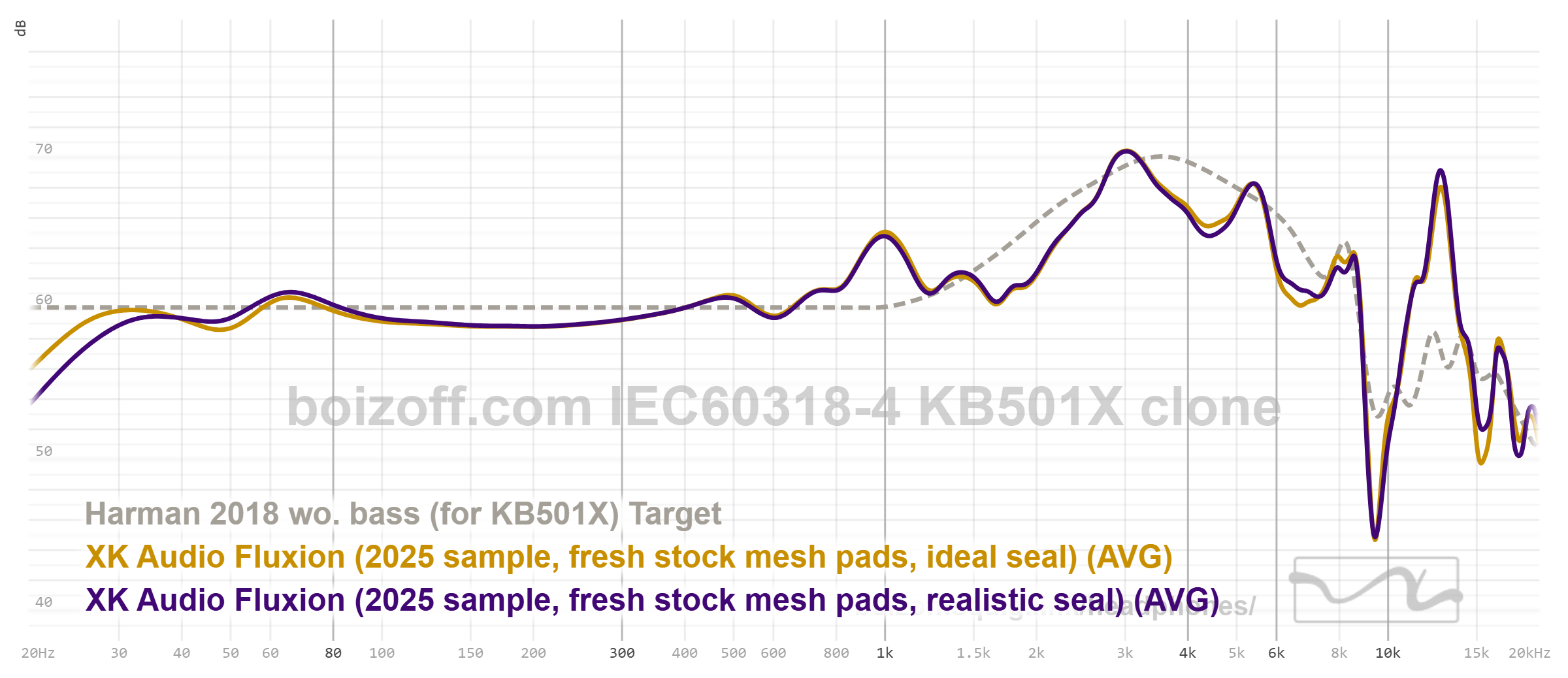
Compared to leather earpads with blocked holes:
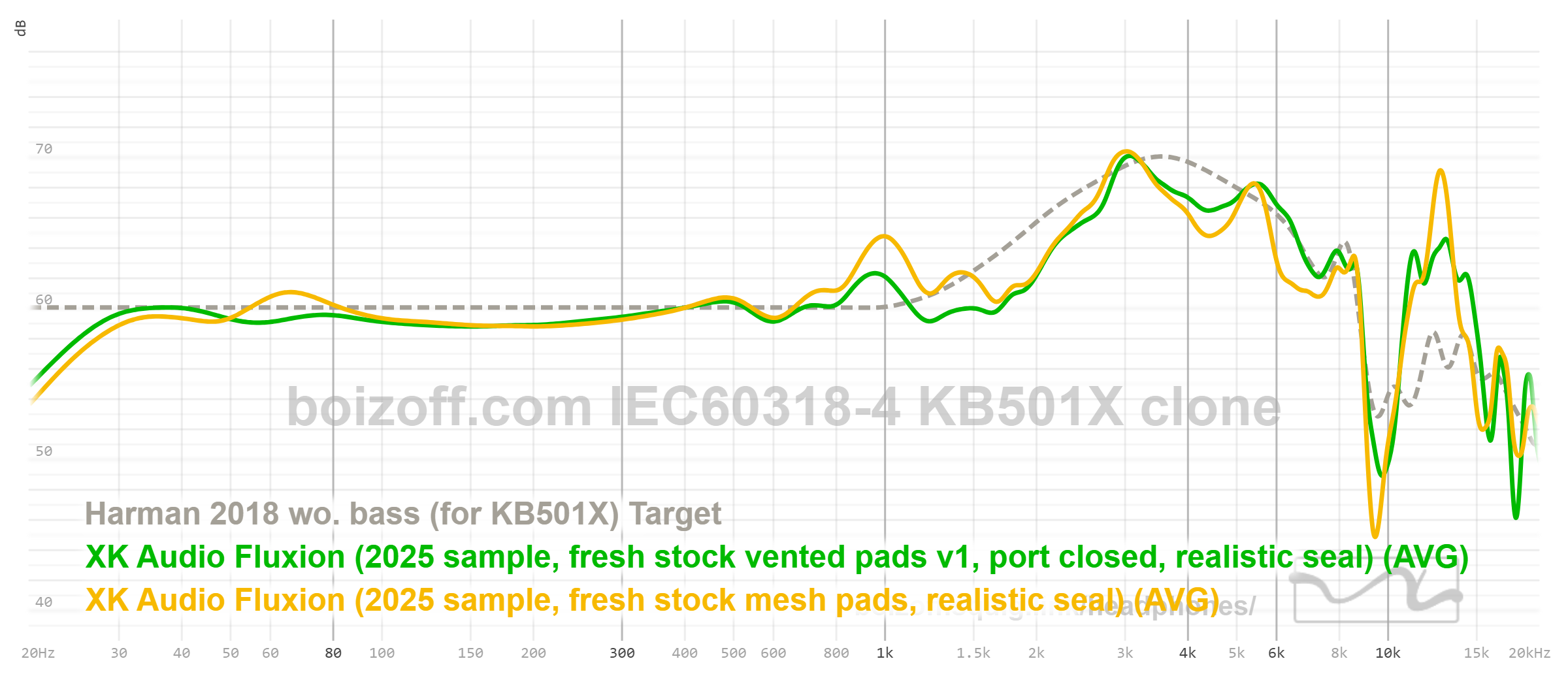
Let’s all together pay attention to the specificities around 1 kHz and 13 kHz and express our displeasure with the fact that there are no standard plugs for tubes in the earpads – it seems that it would be better if the manufacturer put them rather than meshy earpads in the kit.
Fabric earpads with holes, with the holes open and a perfect fit on the rig:
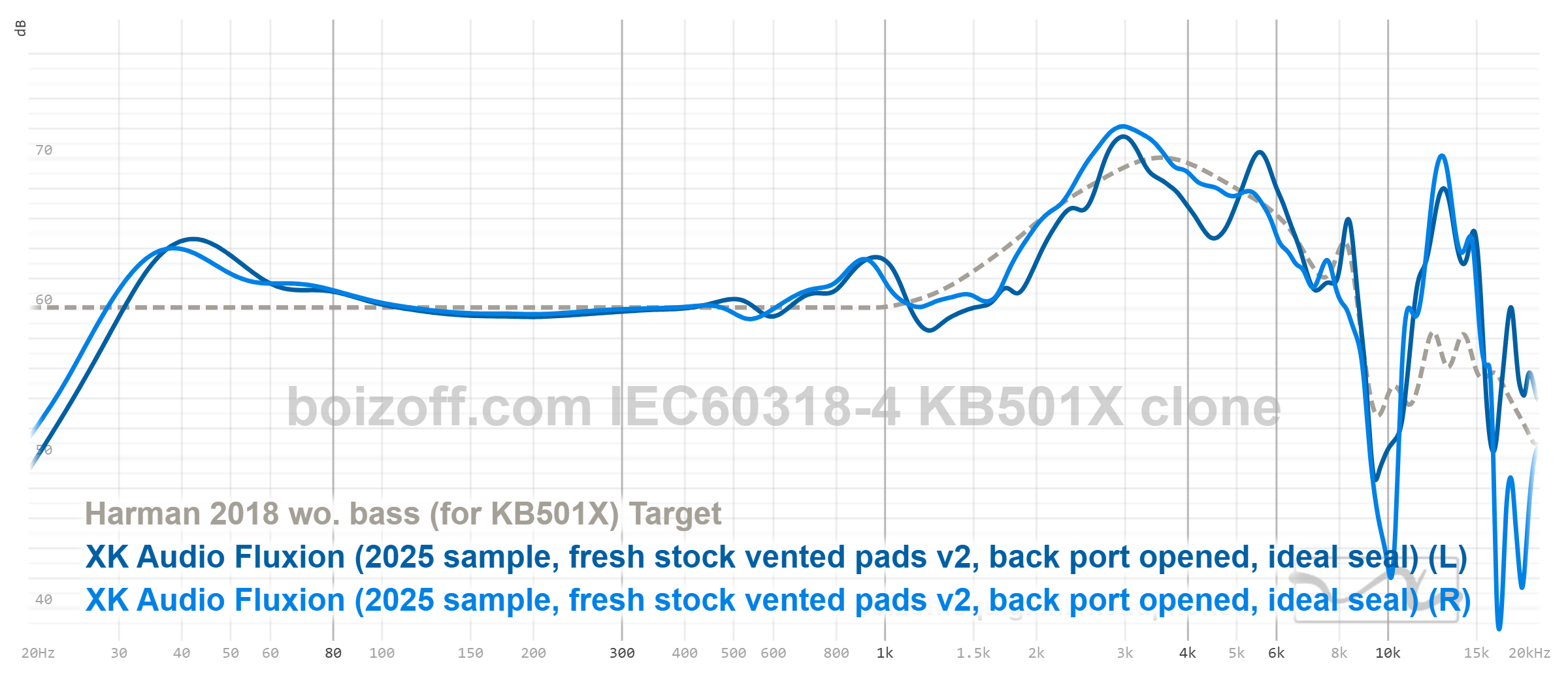
The earpads are sewn way too badly (compare channel discrepancies with those in the picture for the leather earpads above).
Fabric earpads with holes, with the holes open, a perfect fit and a fit with an air gap:
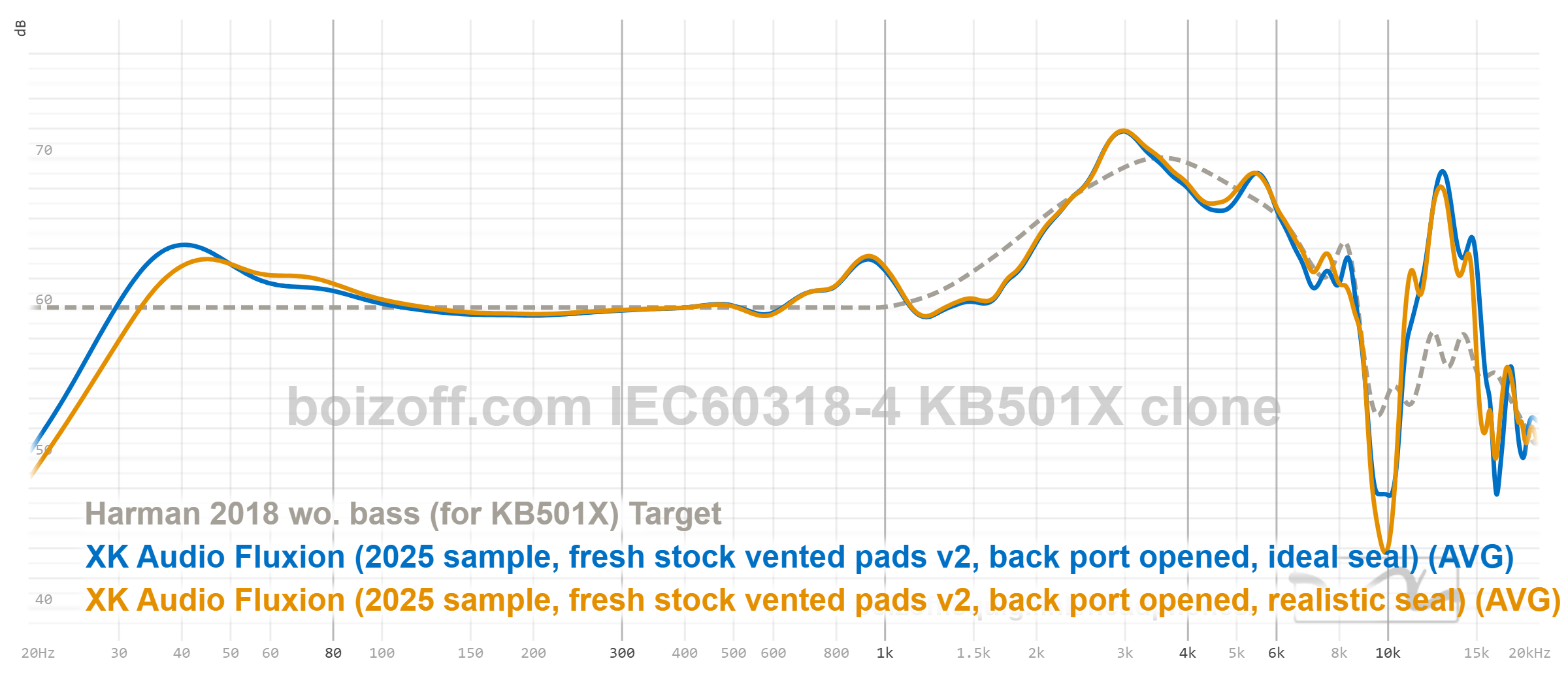
Fabric earpads with holes, with the holes closed, a perfect fit and a fit with an air gap:
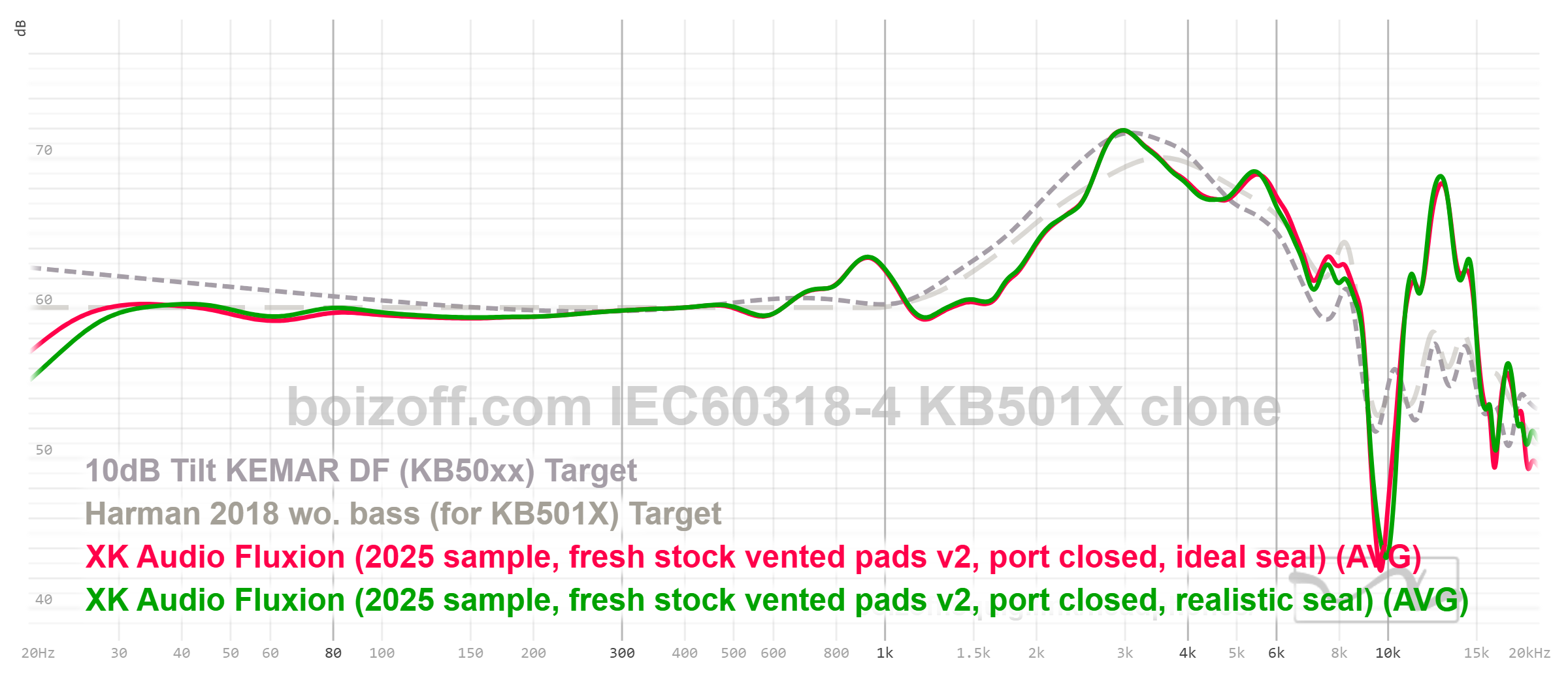
Comparison of frequency responses of leather and fabric earpads with the holes open:
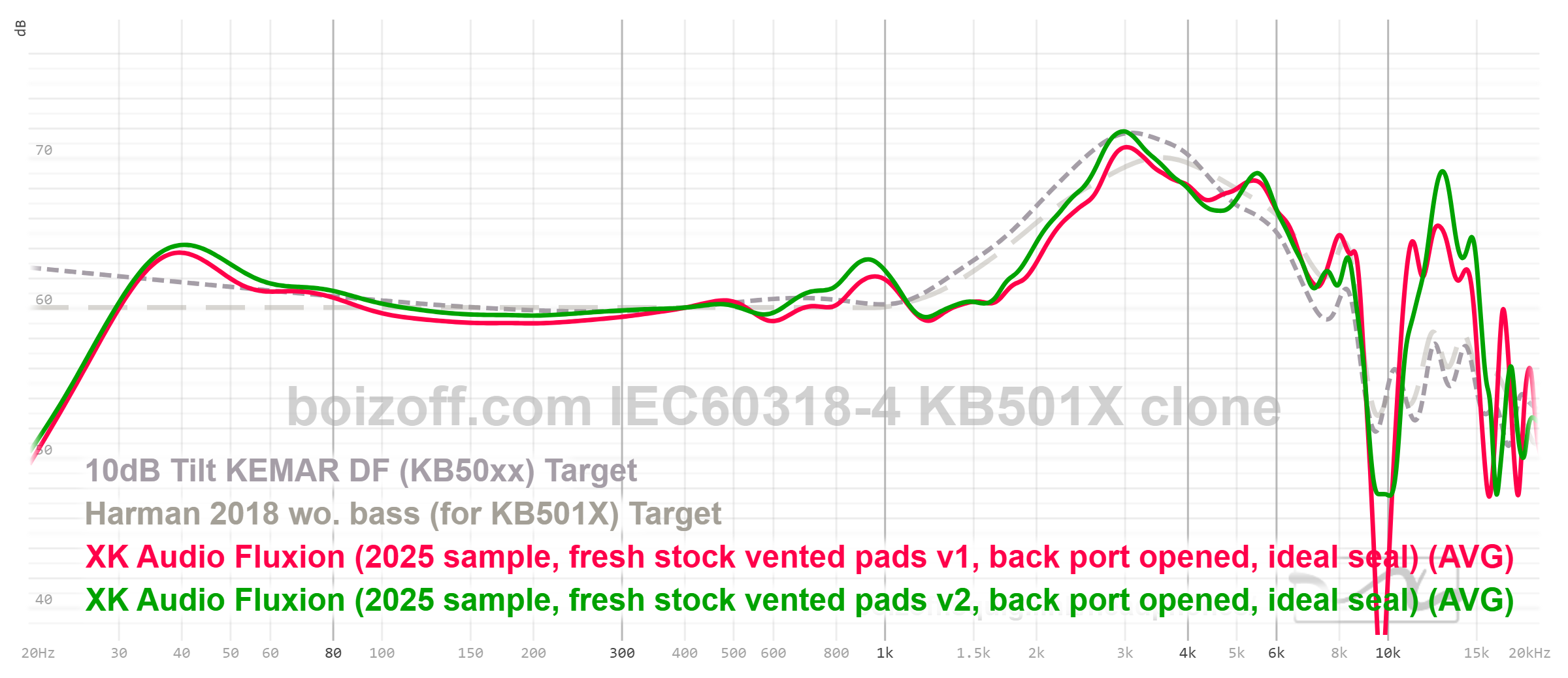
Comparison of frequency responses of leather and fabric earpads with the holes closed:
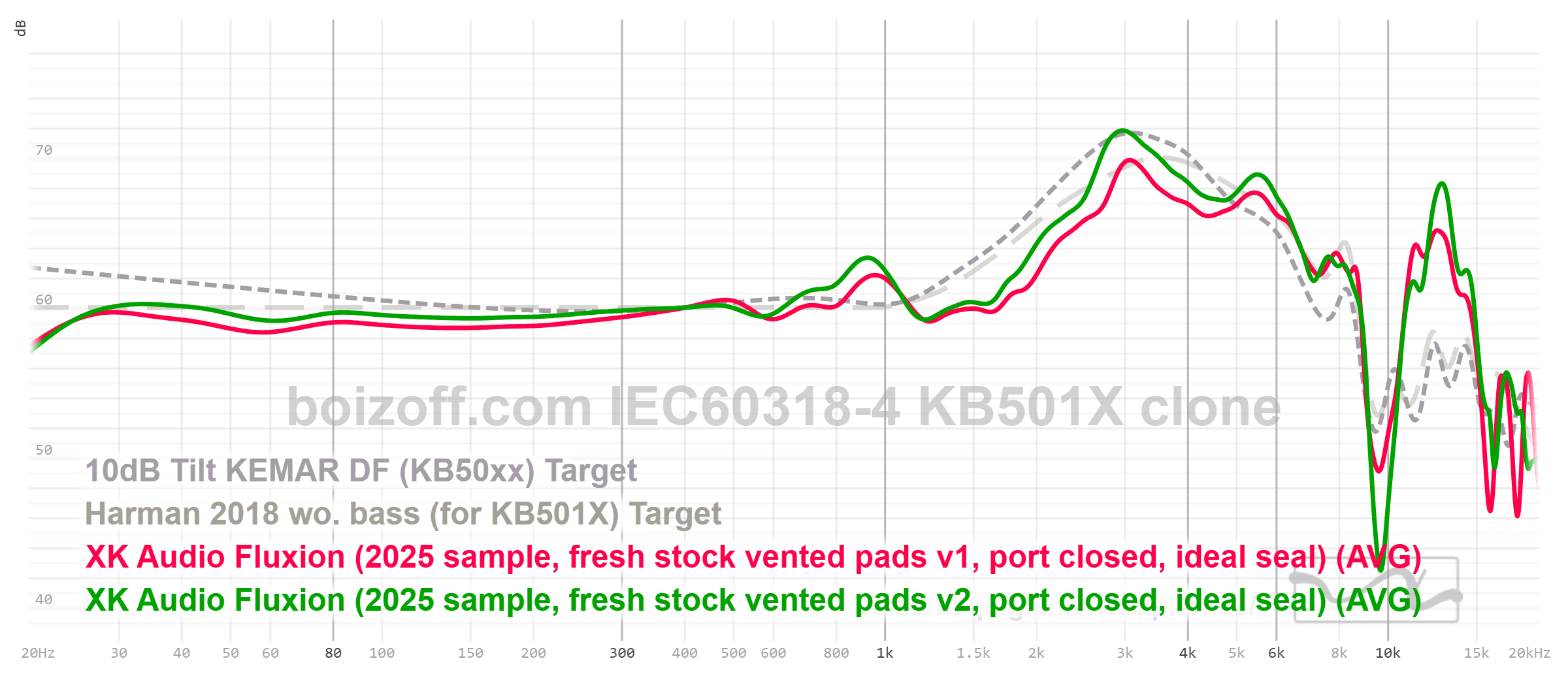
Based on the pictures above, it turns out that fabric earpads are much worse than leather ones in terms of sound:
- They provide a larger channel discrepancy.
- They provide a higher peak at 13 kHz.
- They provide more emphasis on 1 kHz and in the range of 2-6 kHz.
Therefore, I don’t see any point in using them, especially since the cooling effect is not really pronounced.
I would take measurements with third-party earpads, since I do have them, but it’s not that simple: earpads with a diameter of 10 cm fit very poorly on a 10.5 cm mount, and some do that only once. They just stretch irreversibly, and I don’t feel like damaging them. Therefore, there were no experiments. On the other hand, I’m sure that it won’t be possible to radically improve the Fluxion sound by simply changing the earpads.
As for graphs of distortion, group delay, etc. (and now I can also measure them in a good way and not in an old-fashioned one), I asked for a comment from a person who understands this better than me – Dmitry ‘Yukij’ Tretyakov, a sound engineer and audio enthusiast (Telegram channel: yukij_th).
Giving the floor to Dmitry:
“Nonlinear distortion graph with the ‘Use harmonic frequency as ref’ option turned on:
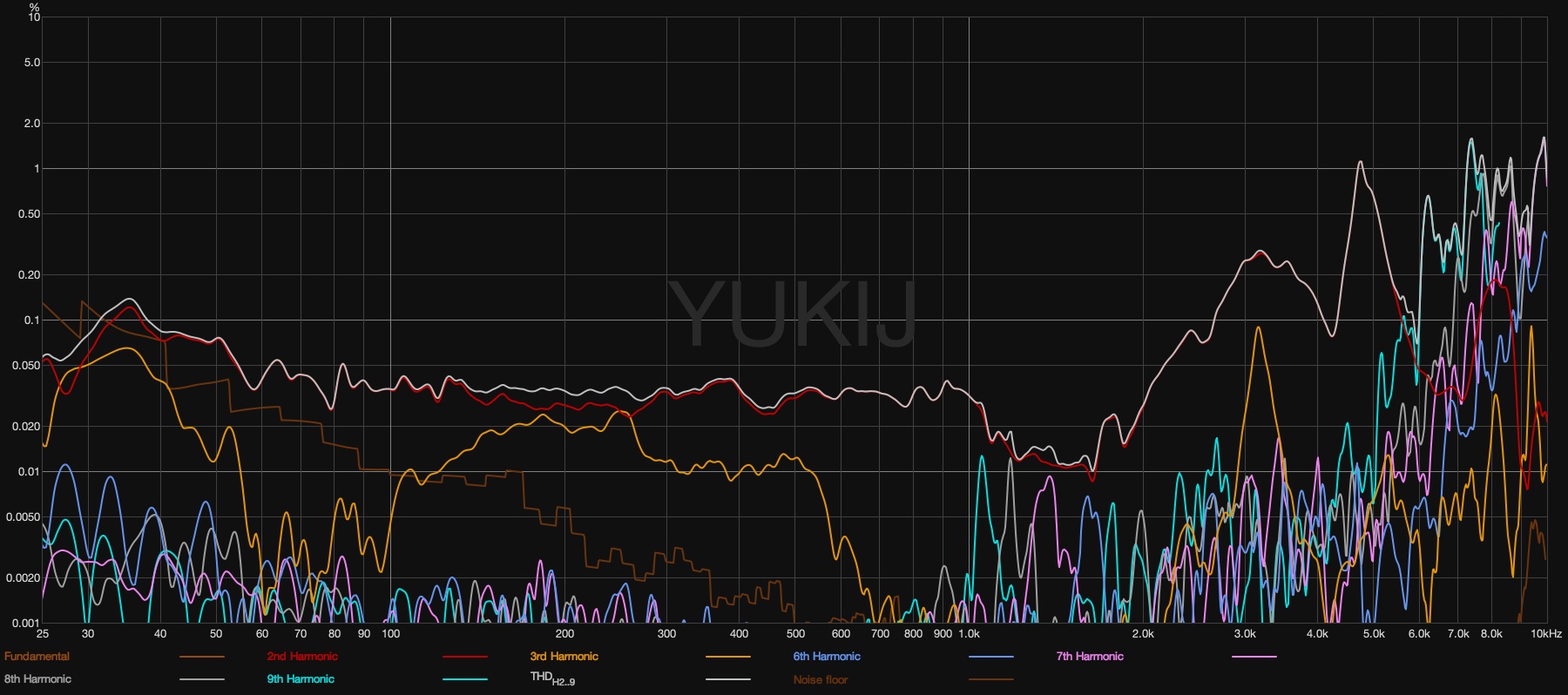
Over the entire range up to 3 kHz, distortion is beyond perception (about 0.15%), which gives you freedom to adjust the amount of bass without noticeably affecting the sound. In the range of 3-4.5 kHz, the second harmonic increases to 1%. Despite the fact that this is already an audible spectrum, the impact on the auditory experience remains minimal.
Group delay graph:
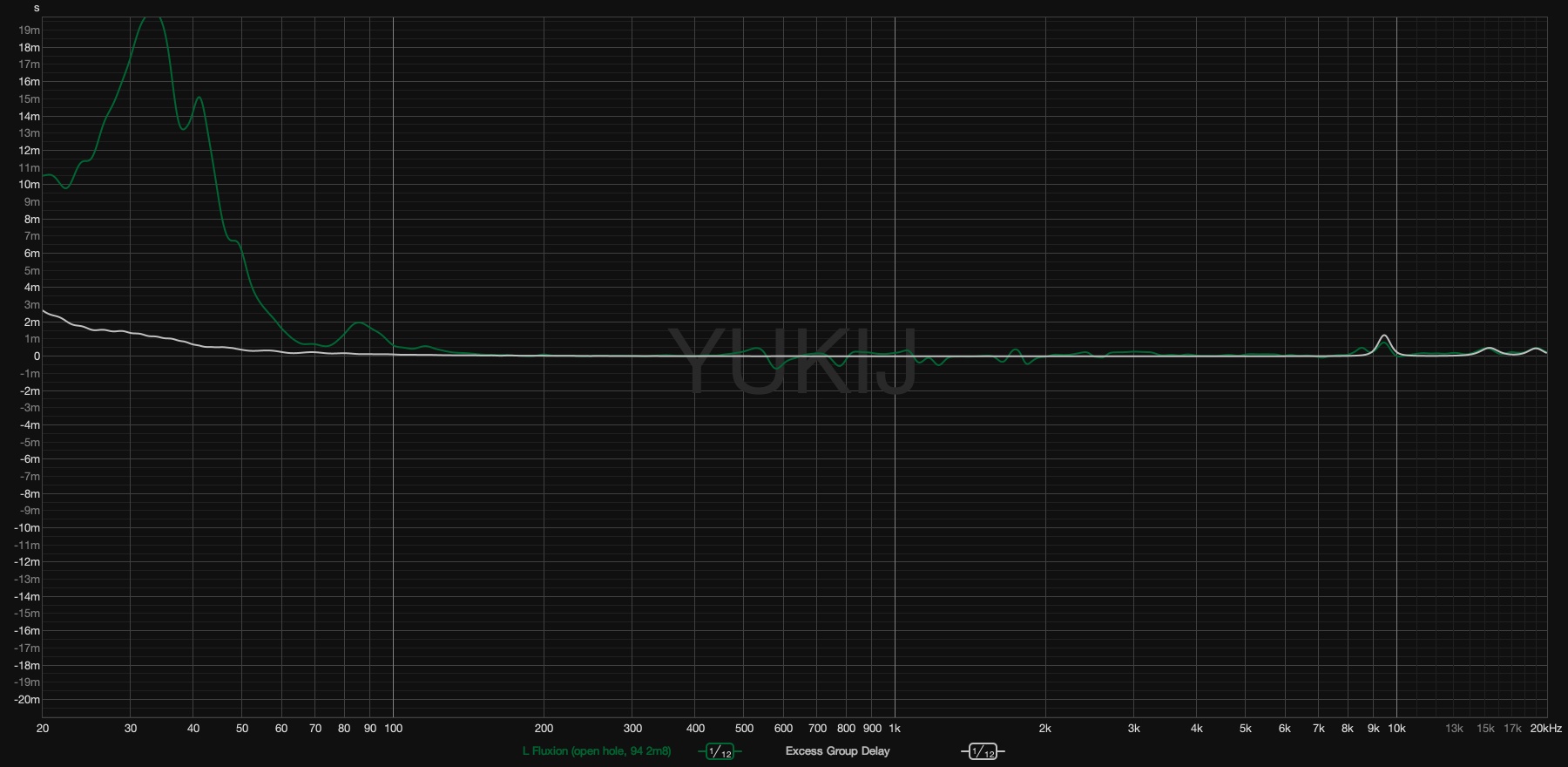
Group delay shows minor deviations from the minimum phase system. The only caveat is an increase at 9.5 kHz (and, as a result, a dip in the frequency response), which cannot be fixed with an equalizer.
A spectrogram with normalization via the Fourier transform:
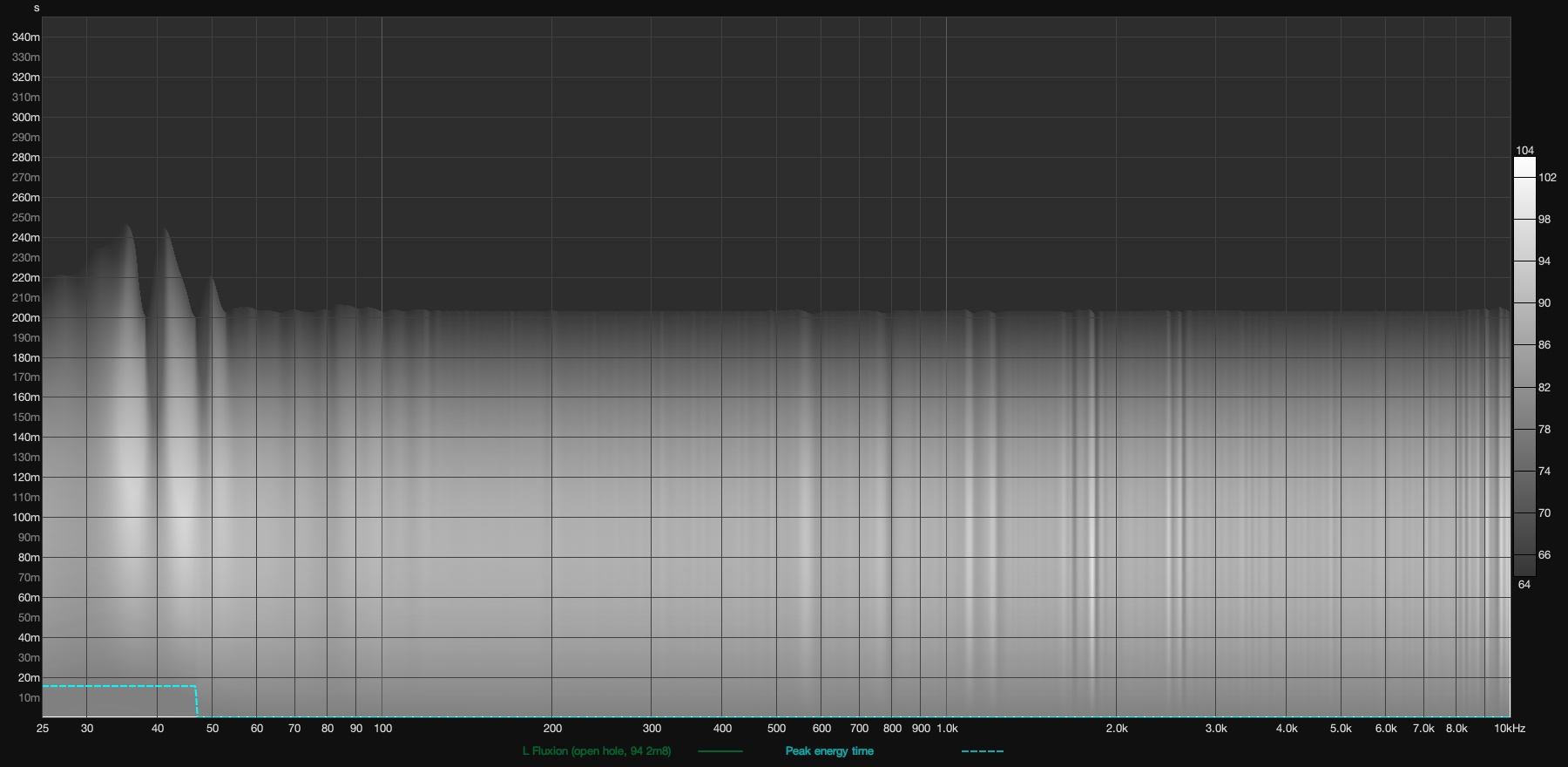
The spectrogram shows only slightly longer fades at frequencies of 35 and 41 Hz.”
As for my subjective take on the sound (I’ve warmed up the headphones since the heating has been recently turned on), I liked it. The main quality of the Fluxion sound is high tonal accuracy, realistic sound delivery, as well as meaningfulness. At the same time, the sound is not boring, it does not strain your ears and allows you not to get tired of listening to music for hours. Personally, I liked the option with plugged holes in the earpads most. I’m ready to change the lack of emphasis on 40 Hz to a slight decrease in volume in the 4-6 kHz range. It’ll depend on the track whether the music will sound large-scale or intimate, near or far, but headphones will convey this feeling anyway. The tuning is not universal, and it is just that ‘mountain’ after 10 kHz that spoils it. It’s ideal for listening to any electronic and academic music, as well as everything recorded from analog instruments: Zero Gravity (Contemporary Noise Ensemble), Sobs (Low Kick Collective), Bad News (Melody Gardot), something like that. But in other genres, you’ll have to be selective in performers and recording quality: if the range about 13 kHz in a track is saturated with information and volume, it may sound uncomfortable. Really heavy stuff such as like Burning Bridges, Shattered Dreams (Trna), …and with hope you’ll be damned (Paleface Swiss),Pagan Savior (Black Royal), Bones in the Water (Battle Of Mice) is very ‘technical’, very ‘detailed’, but it doesn’t ‘rock’, and it ‘scratches’ your hearing with ultra-high frequencies.
13 kHz can be adjusted via the equalizer since there’s no need to fix anything else in the Fluxion sound. And then Fluxion can be used for almost any normally recorded music, indeed. And you can open or close the holes on the earpads as the mood takes you.
Comparisons
Floating around the Internet, you can find incredibly enthusiastic opinions about Fluxion – they are compared as much as with HiFiMan Susvara Unveiled, and people say they are almost identical in sound. Others put Fluxion somewhere between HiFiMan HE1000 and ‘regular’ Susvara. All things considered, if you compare them with models with approximately the same price, then you should have chosen something like Arya Organic.
But the comparison should be informative for the reader. Do you know anyone who has heard Susvara Unveiled? Neither do I. Therefore, I decided to compare them with what’s famous and expensive: Moondrop PARA and HiFiMan HE1000 Stealth.
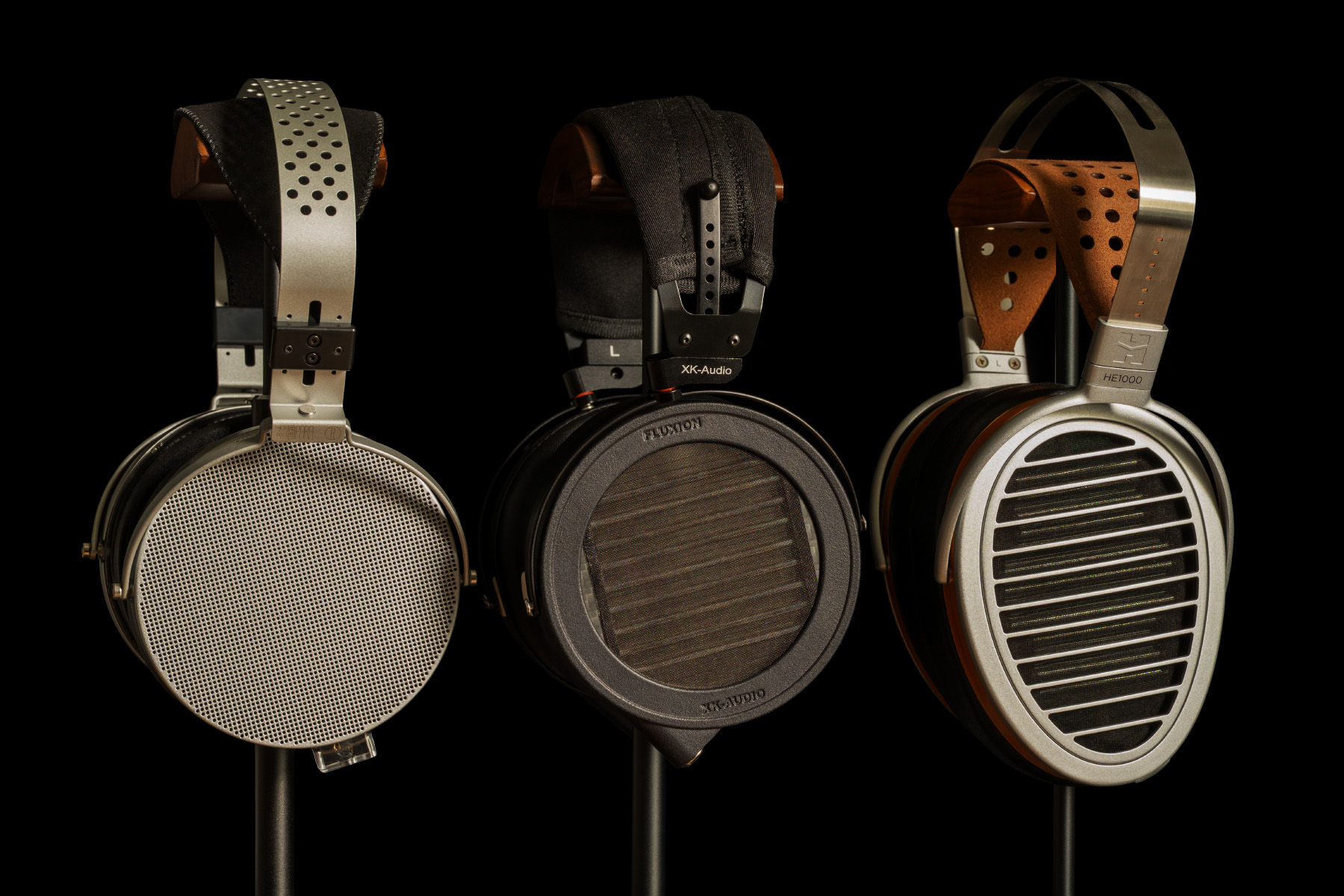
The first headphones are popular and affordable, the second ones are slightly less popular, but they cost twice as much as Fluxion. Both are open-back planars.
Frequency response of XK Audio Fluxion and Moondrop PARA:
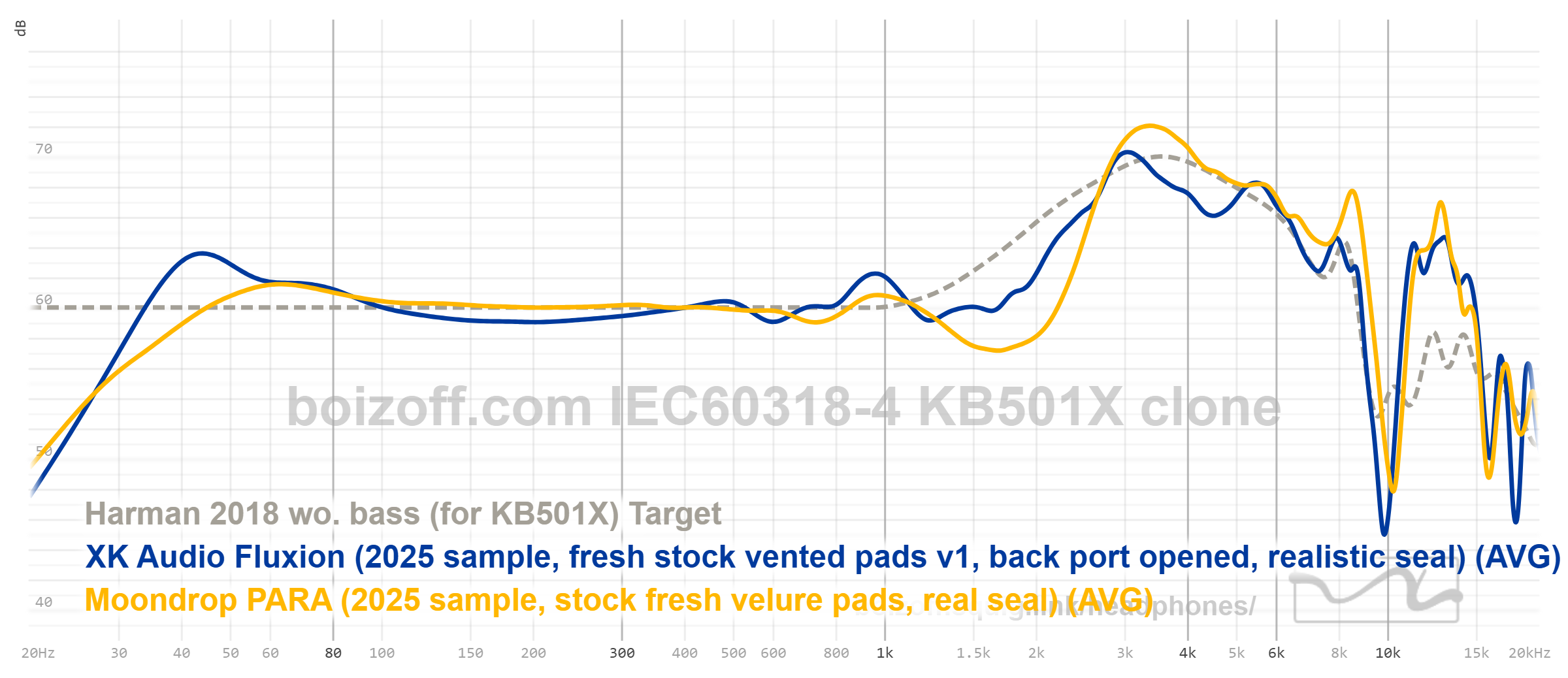
PARA sounds sharper, tougher, they have a fewer return on the subbass and a larger dip at 1.5 kHz. The Fluxion’s sound is definitely better in everything. They sound more balanced, ‘dense’, and authentic. The only thing is that the peak at 13 kHz is inherent in both models of the headphones.
Frequency response of XK Audio Fluxion (with the holes on the earpads closed) and HiFiMan HE100 Stealth:
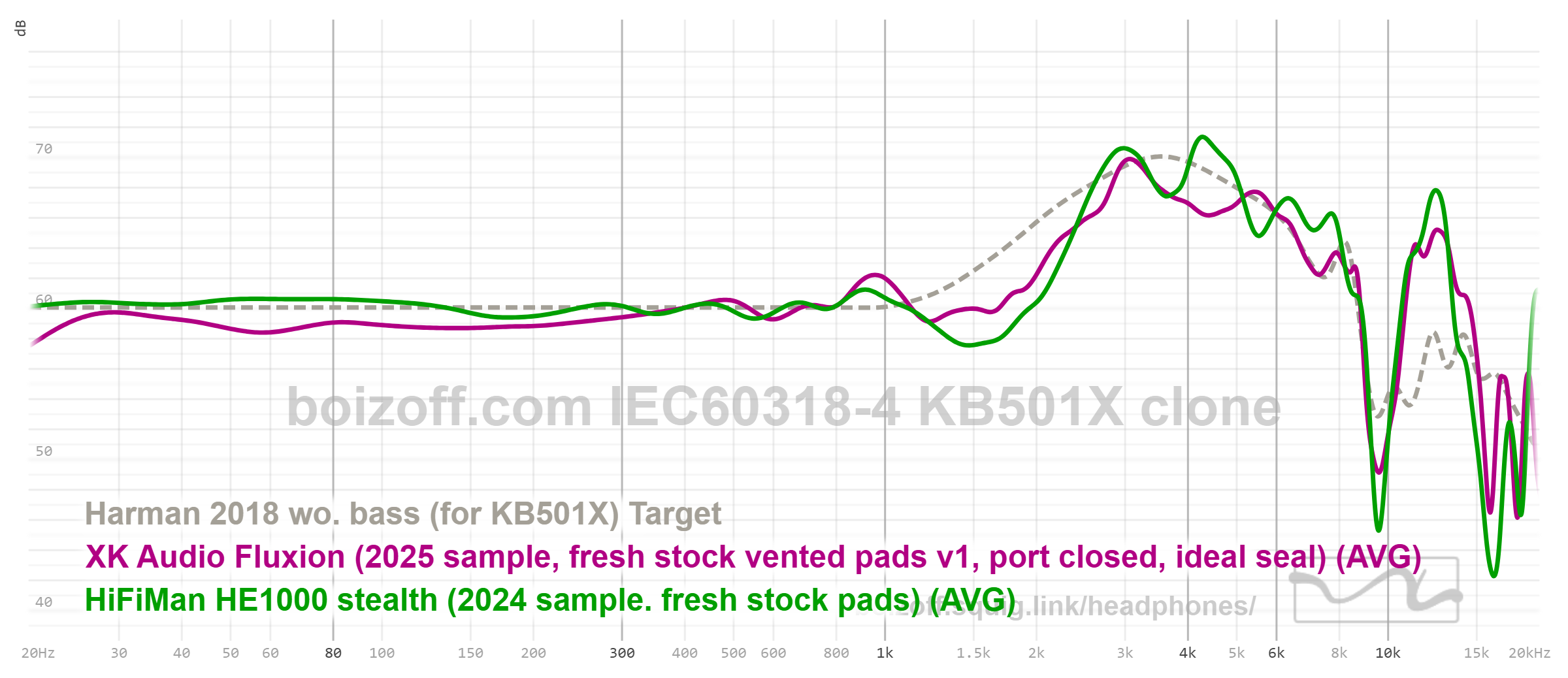
HE100 are smoother in the range of 20-1000 Hz, but then they are on the losing side: again, there is a lesser dip at medium frequencies, the 3-8 kHz range is not so bright and even, and the peak at 13 kHz is even higher.
Obviously, both PARA and HE1000se are manufactured and assembled much better than Fluxion.
Besides, let’s not forget the following:
- Moondrop Laputa are looming on the horizon – the same price, an even more even frequency response (although, judging by the available measurements, the peak at 13 kHz has remained), and, I’m sure, a much better performance. There are no reviews yet as the headphones have just been released, so we can only guess how they will actually perform. There is no emphasis on the subbass, but I assume that if there is an air gap, it will appear.
- the new HiFiMan HE600 – the same price again, about the same frequency response, probably better build quality and parts, but a less comfortable fit (earpads are exactly the same size as Sundara, if I understand correctly). But there’s no peak at 13 kHz.
That is, in terms of sound, Fluxion should get potential competitors in its price niche in the nearest future, no illusions here. And it is highly likely that these competitors will be assembled better. I won’t say anything more specific about the above-mentioned models until I’ve tested, measured, and touched them.
Summary
The accessibility of online information practically eliminates miracles in the sense that I meant in the very beginning: if you can’t find reviews of a particular model of headphones, these headphones are most likely no great shakes, otherwise a song and dance would be given to them.
Is this statement true of Fluxion?
From the point of view of component quality and assembly accuracy, Fluxion are pure DIY: they have a cheap headband, crookedly attached connectors, and a strange inconvenient solution for attaching earpads to earcups. Ergonomics, as a result of these constructive solutions, is not high: everything is fine as long as the headphones are on your head, but as soon as they are in your hands, here comes the frustration – the earcups spin uncontrollably, there are no protective covers, and every time you have to figure out how and where to grip Fluxion.
As for the sound, Fluxion offer a neutral ‘DF-like’ tuning, which is typical for most planars. However, as applied to Fluxion, a number of flaws inherent to such models have been fixed: the sound is weighty due to a slight emphasis on forty hertz (yes, in exchange for loss of information at even lower frequencies – but is there a lot of information there if you consider real tracks?), a dip at about 1.5 kHz is minimal, and the range from 4 to 8 kHz is just flat, so it doesn’t stand out from the rest. Plus, if you plug the holes on the original earpads, the emphasis on the subbass is ‘smoothed out’, and the low-frequency range becomes linear. However, typical pedaling of a section around 13 kHz is still there.
Is this a unique achievement in its price range? Definitely, yes. Is this sound enough to go with Fluxion? It depends on how much you like this sound and whether you are ready to turn a blind eye to all other aspects of these headphones. In other words, from my point of view, Fluxion are worthy of consideration as one of the options for purchase, but they are by no means an obvious choice.
To buy or not to buy Fluxion: damned if I know.

